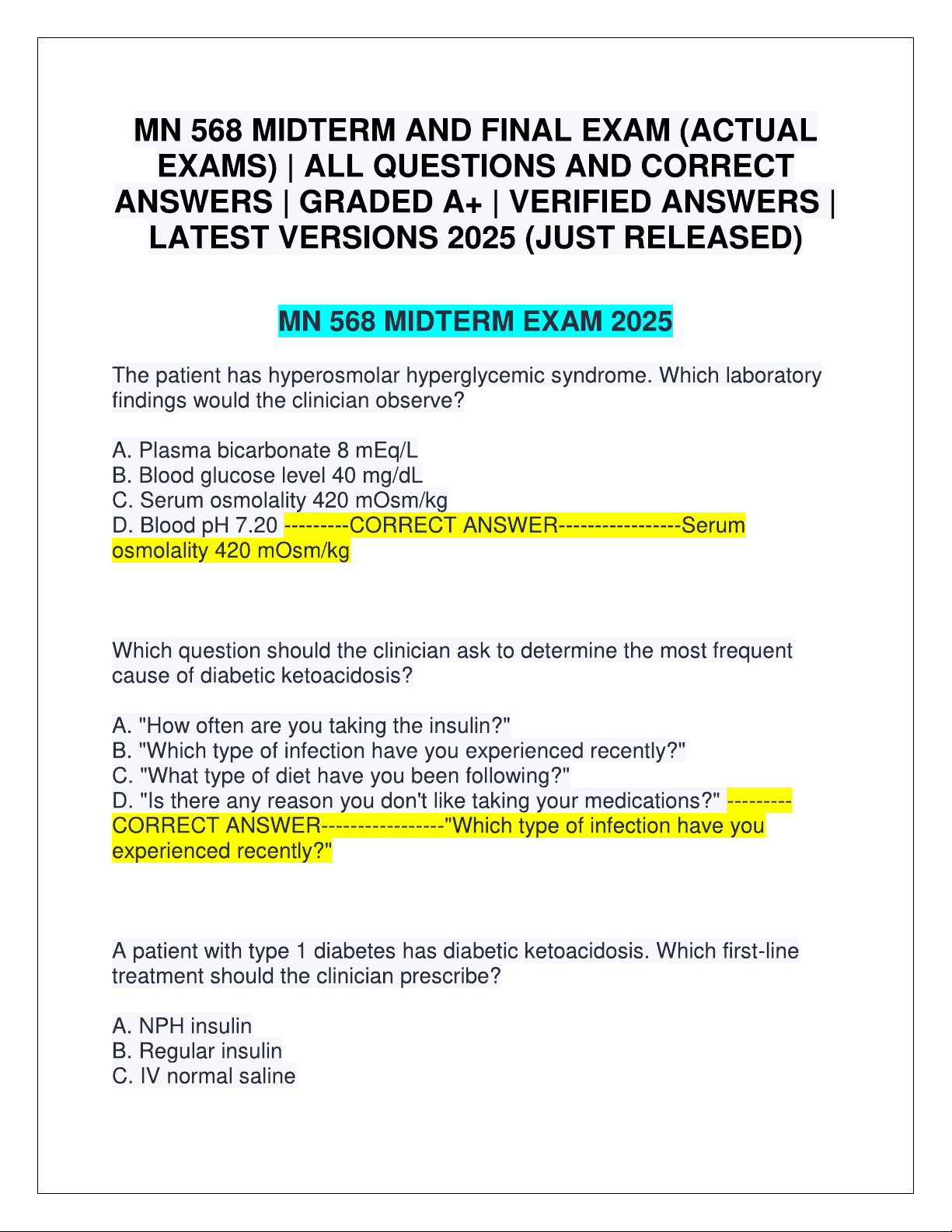
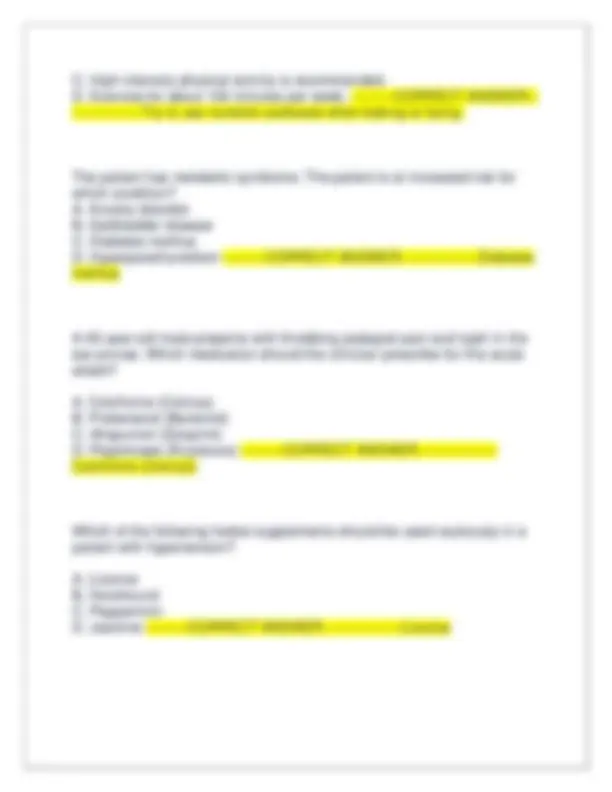
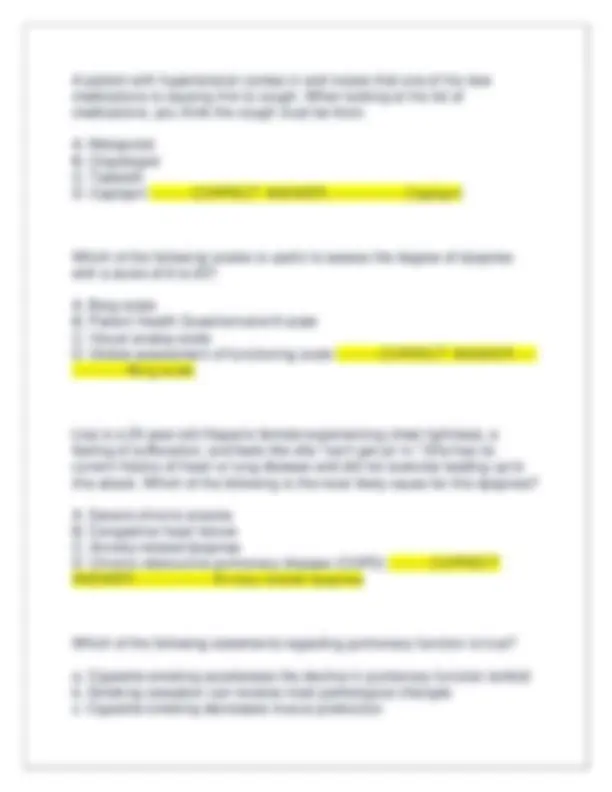
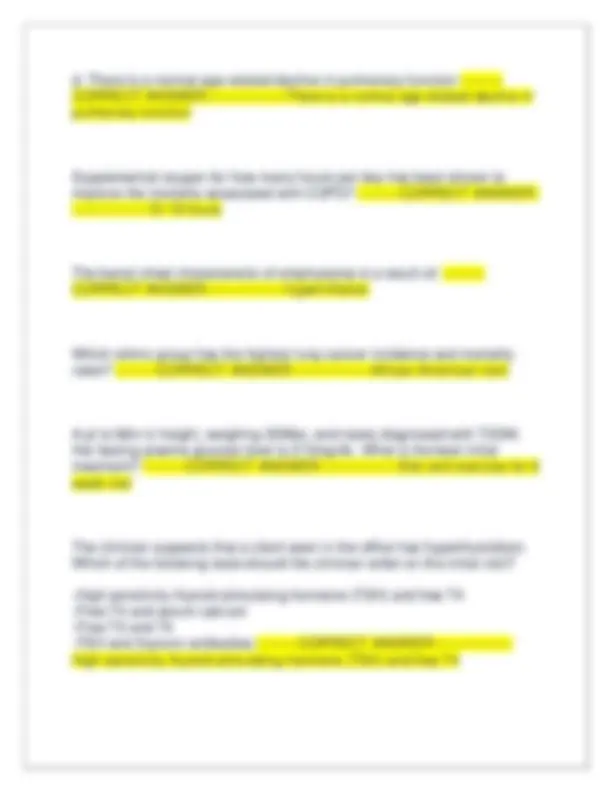
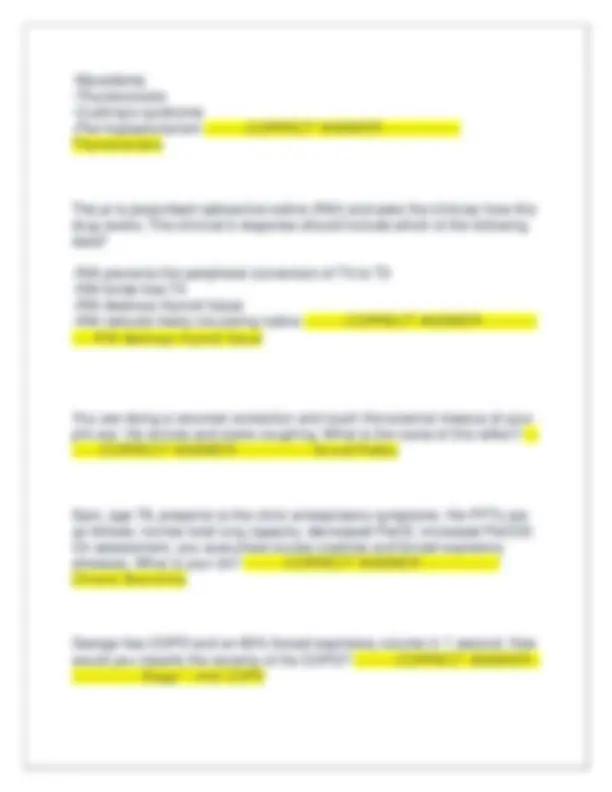
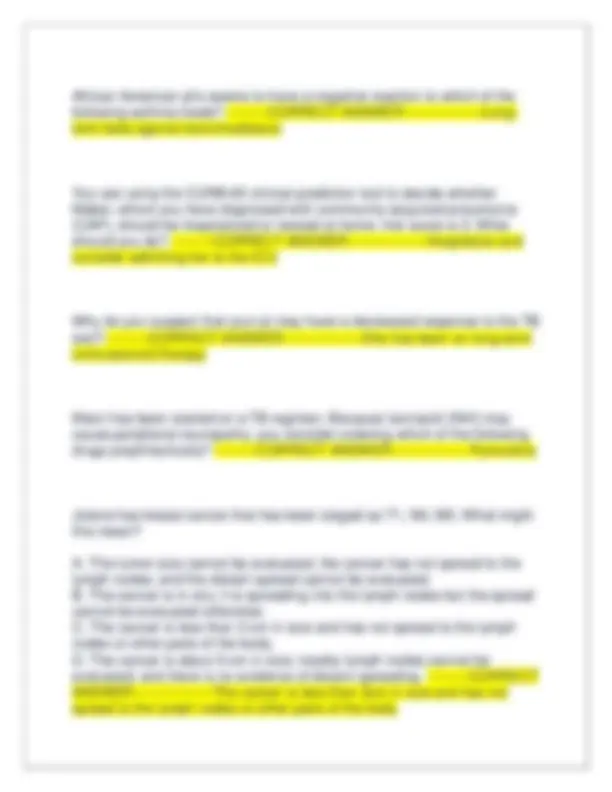
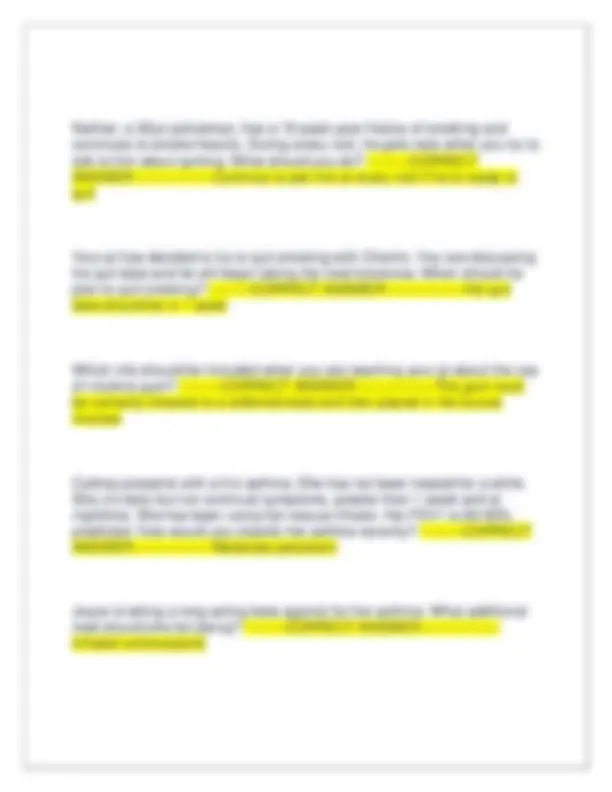
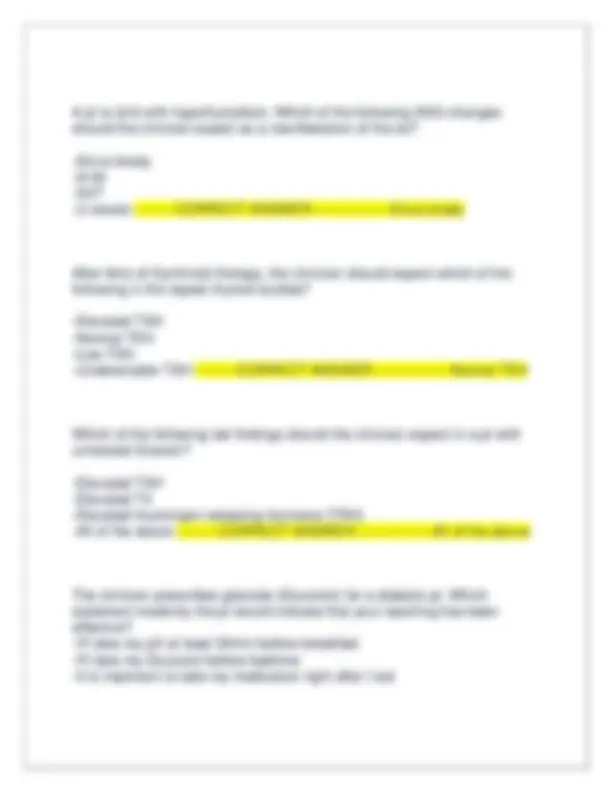
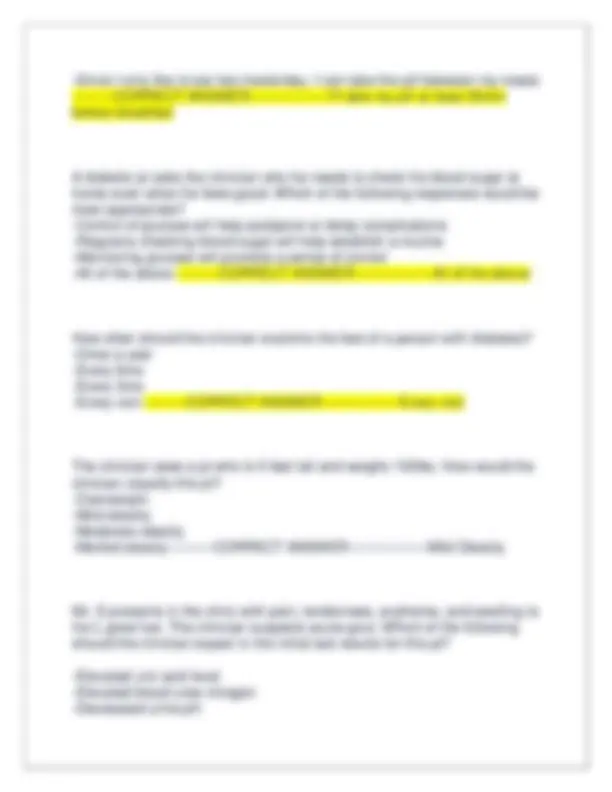
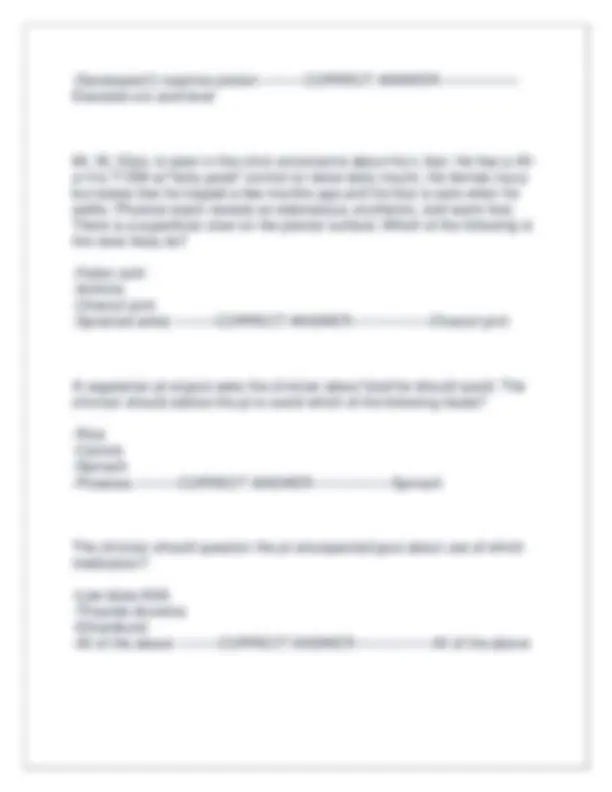
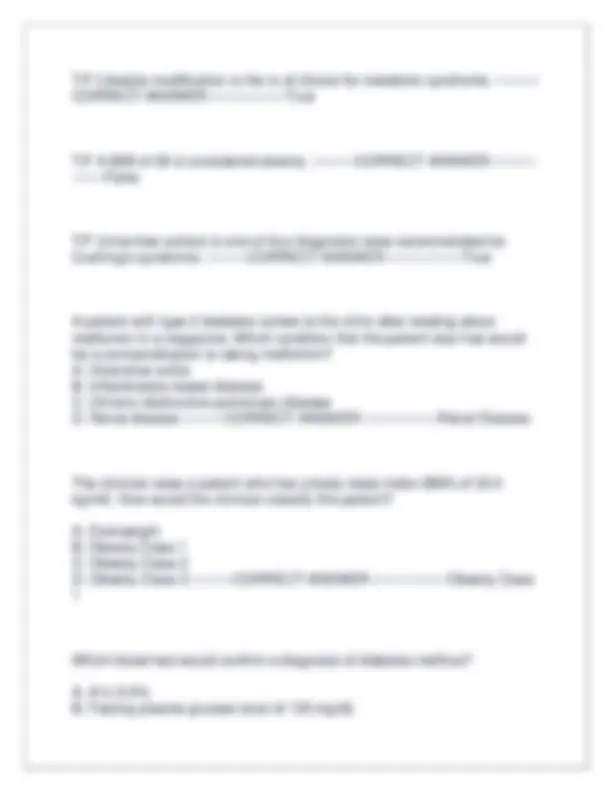
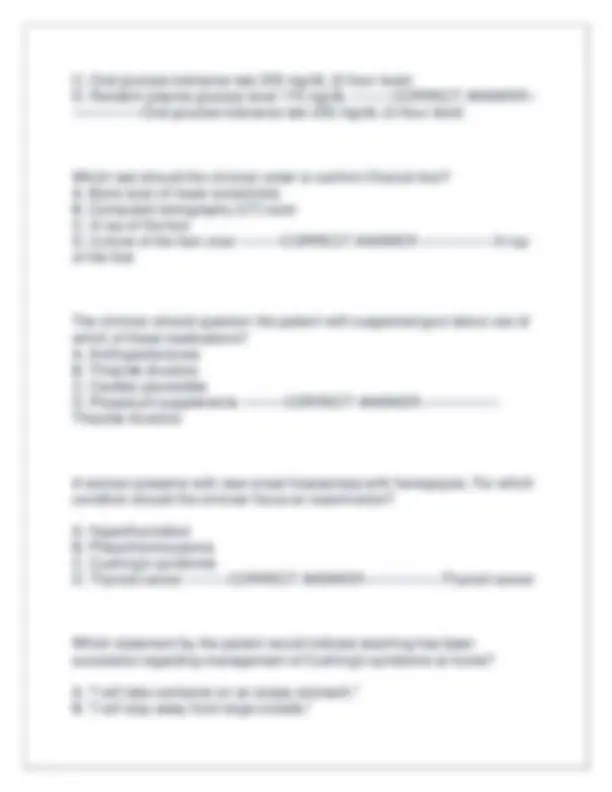
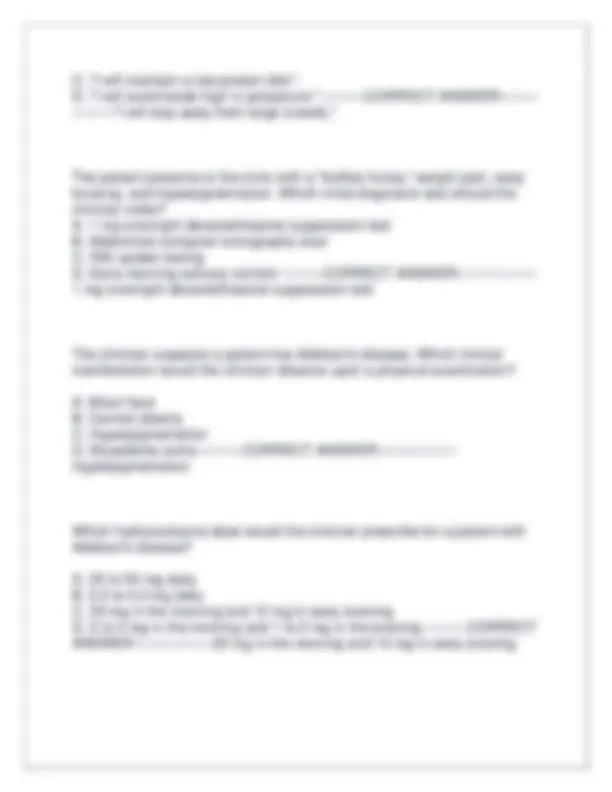
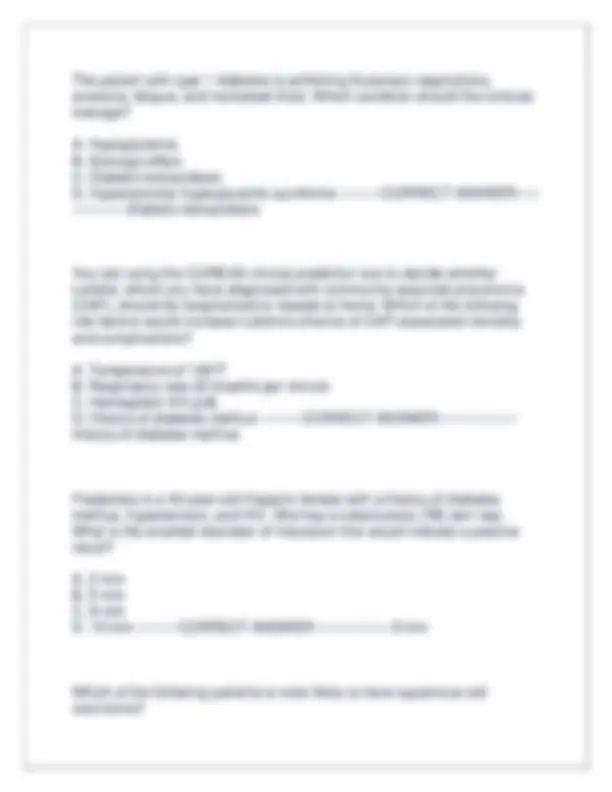
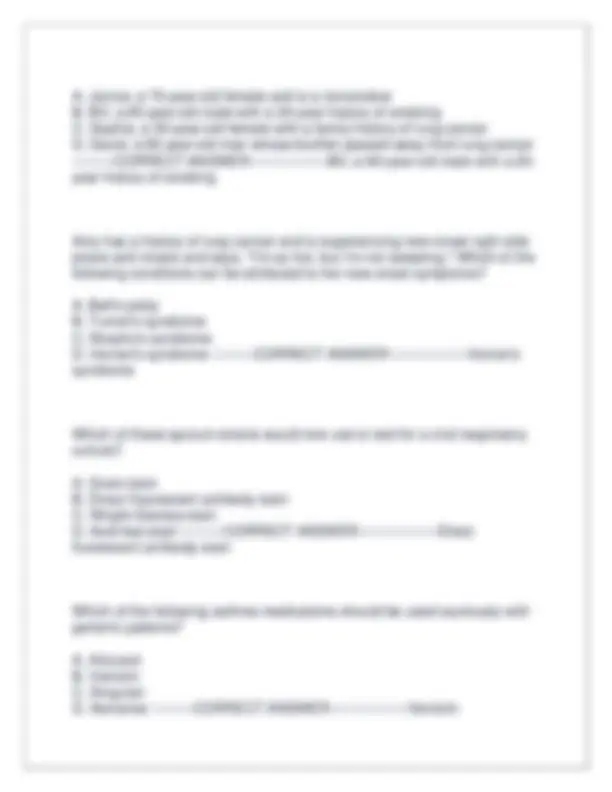
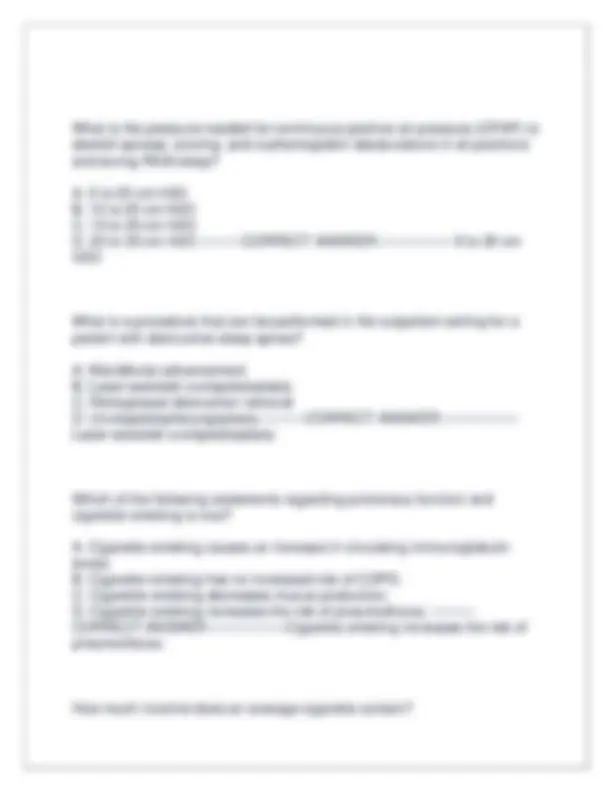
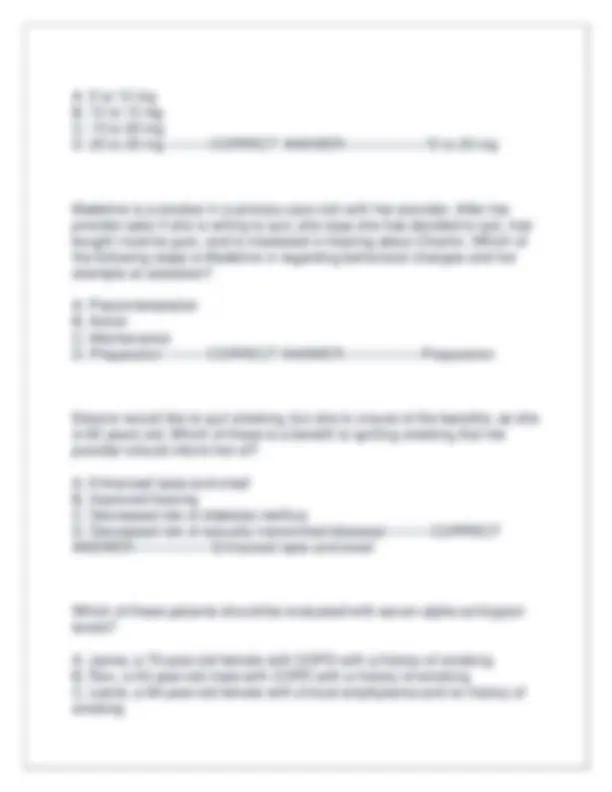
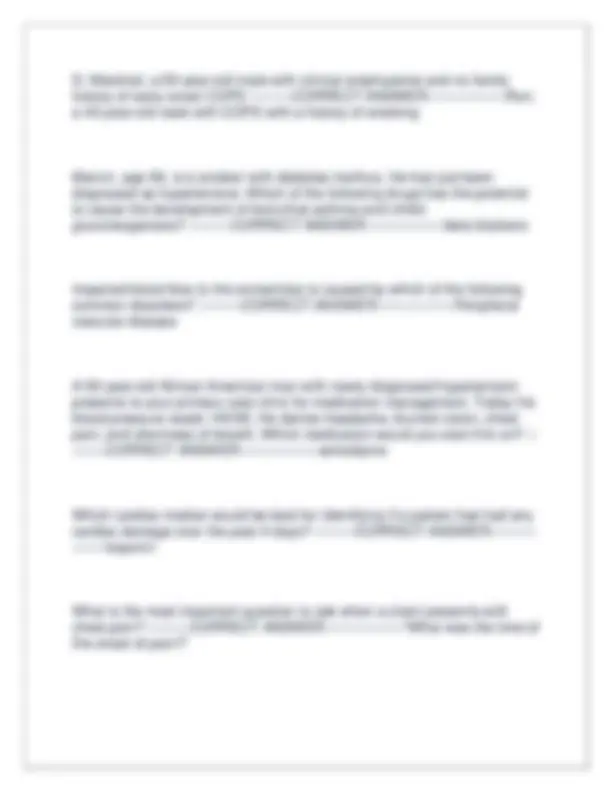
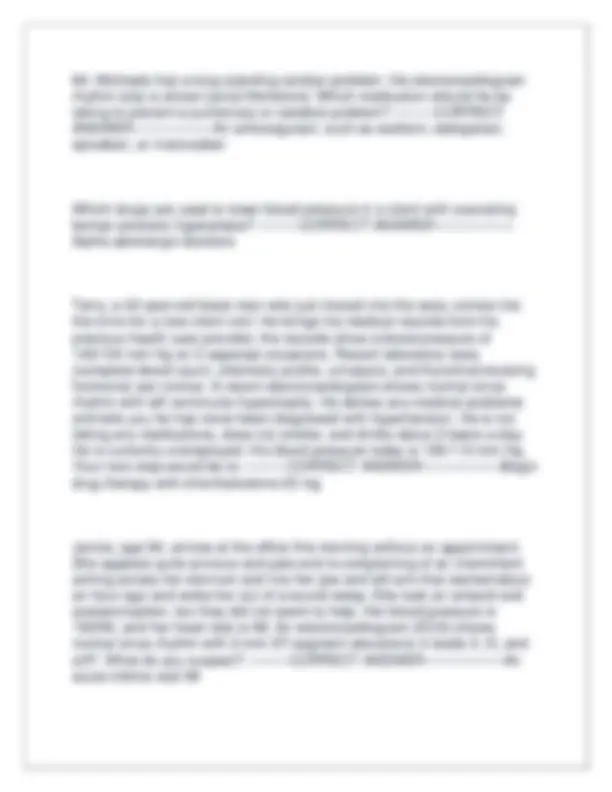
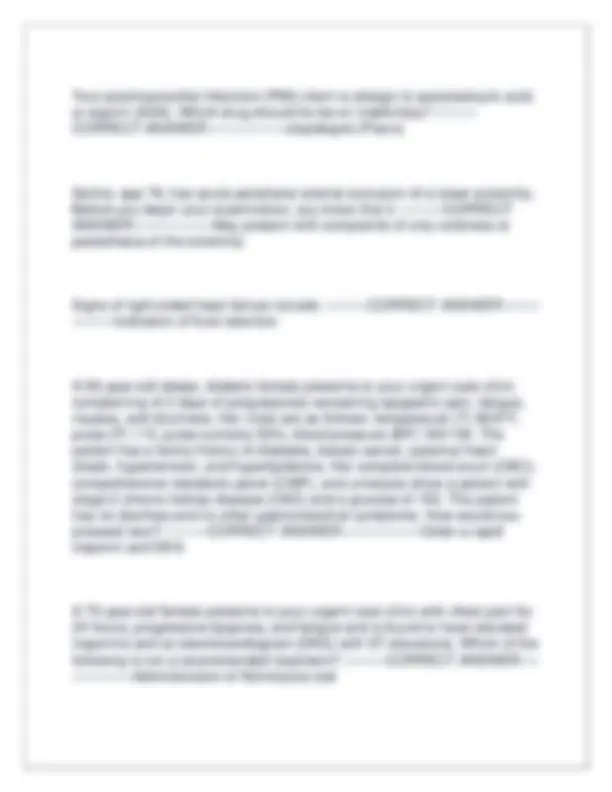
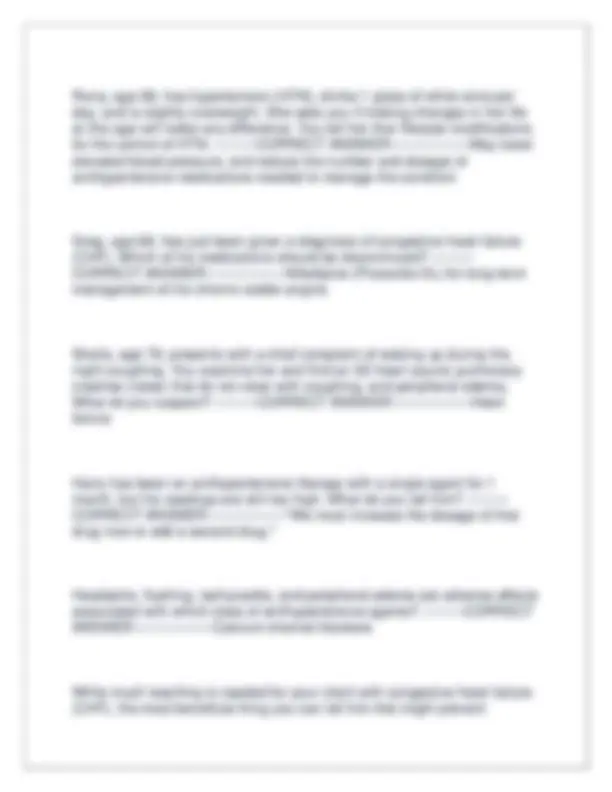
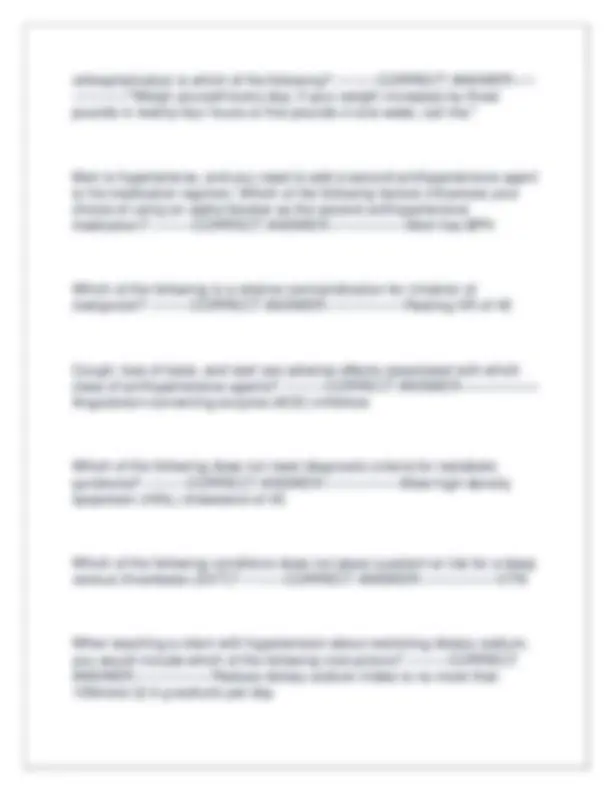
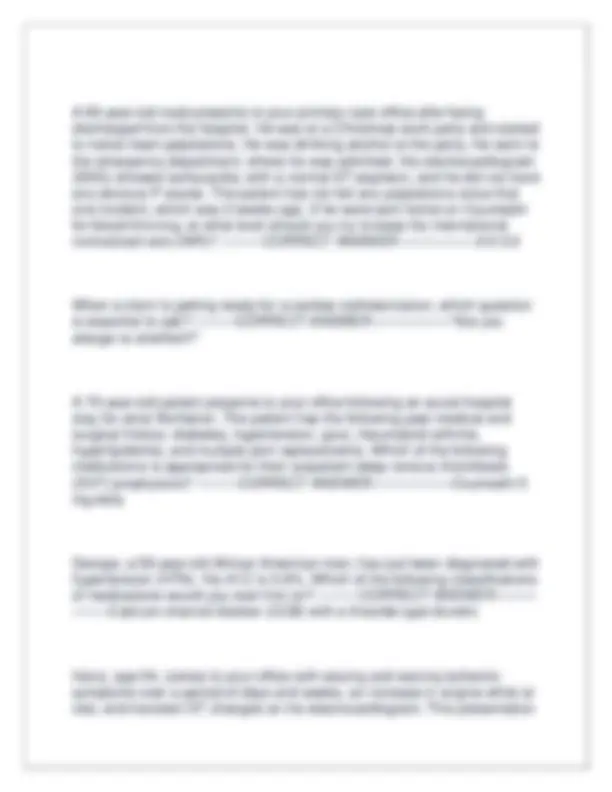
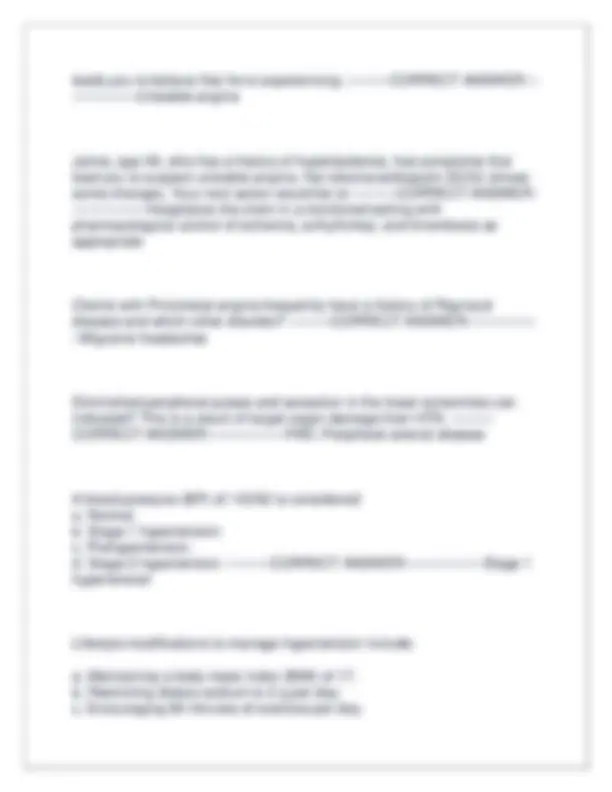
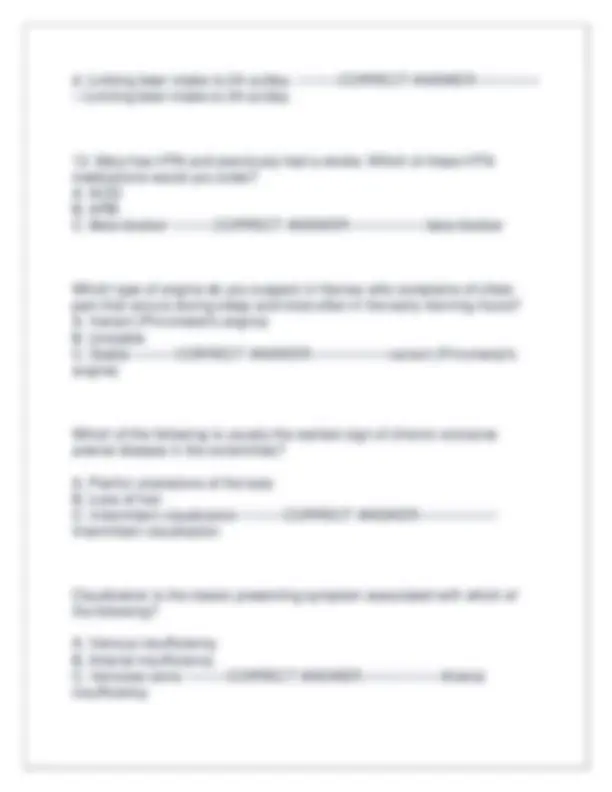
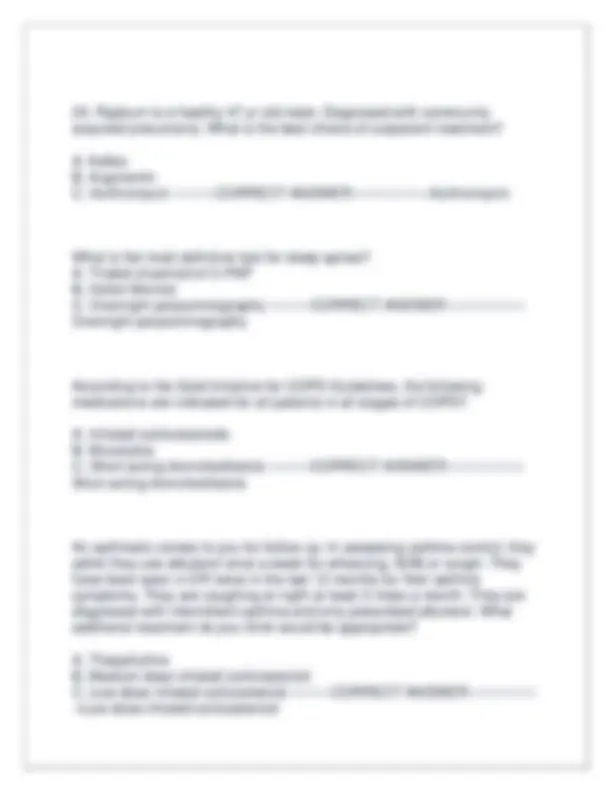
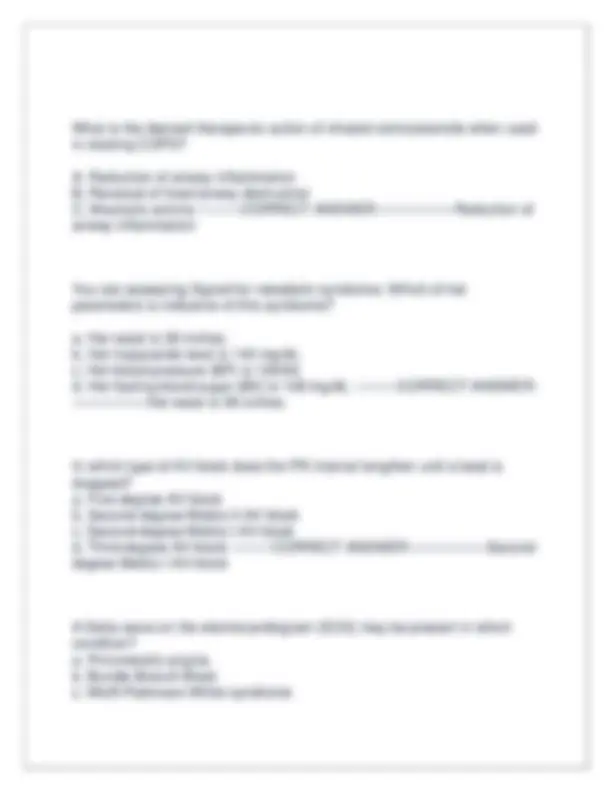
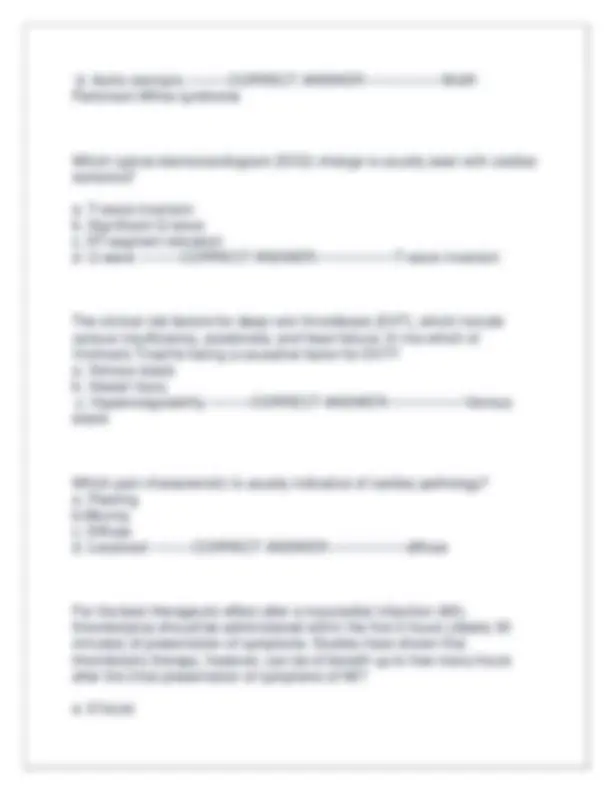
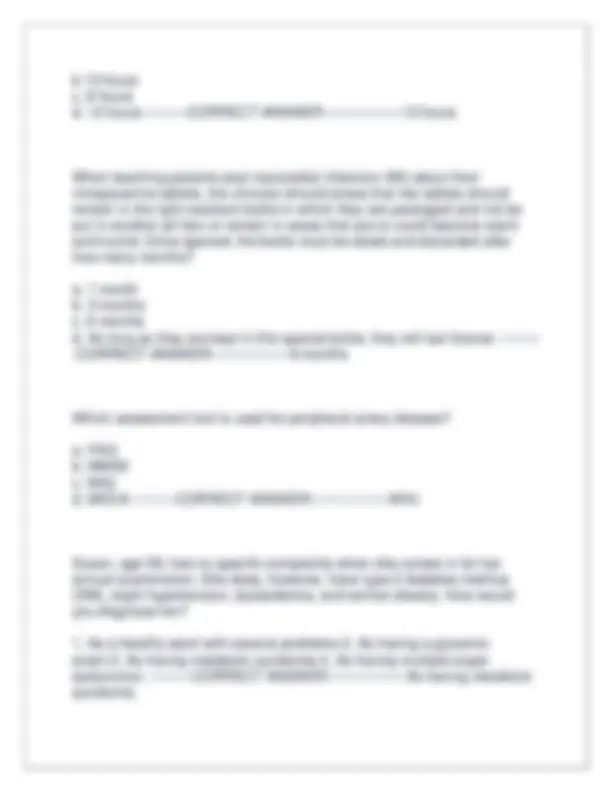
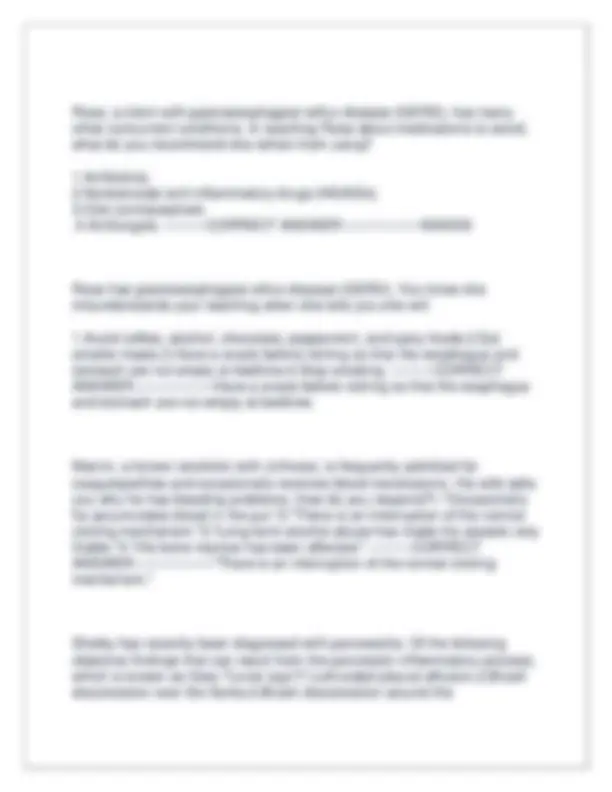
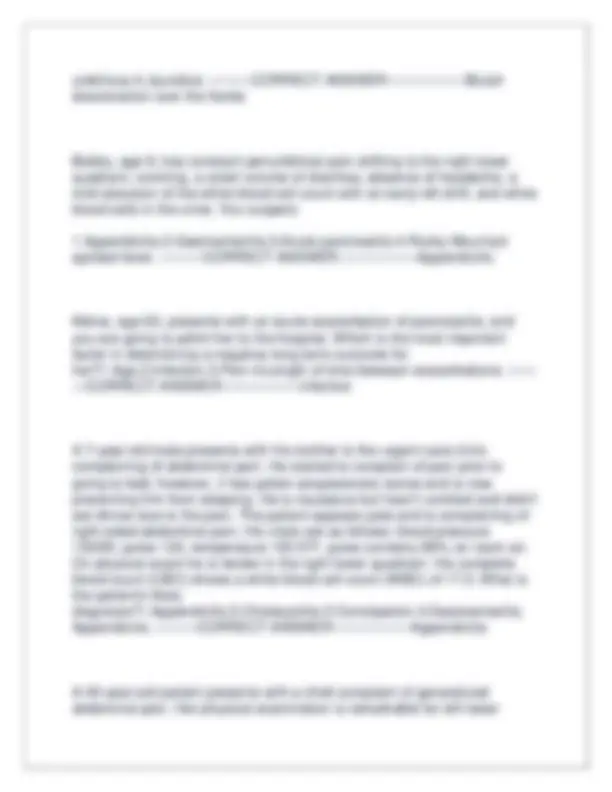
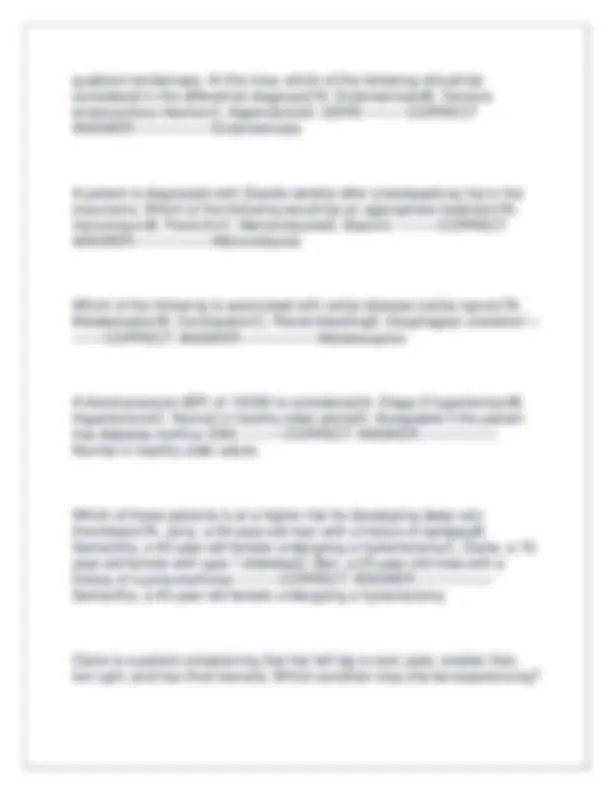
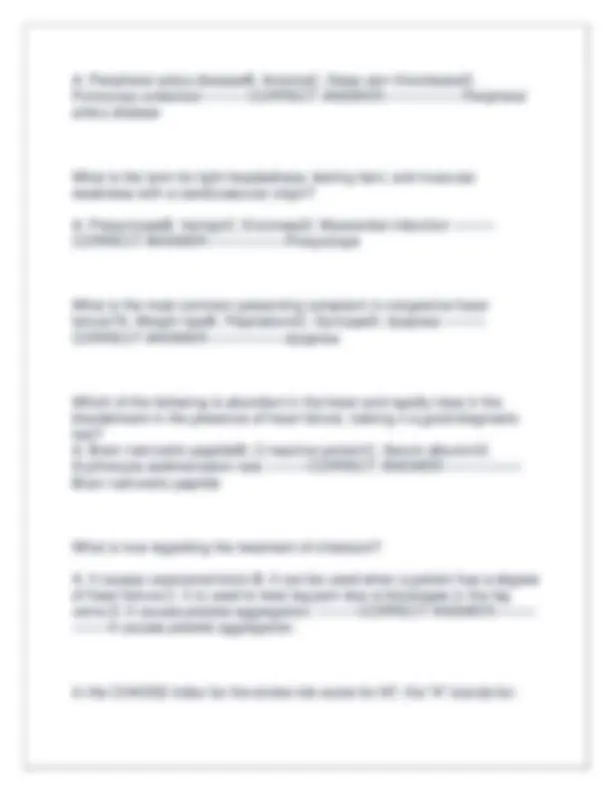
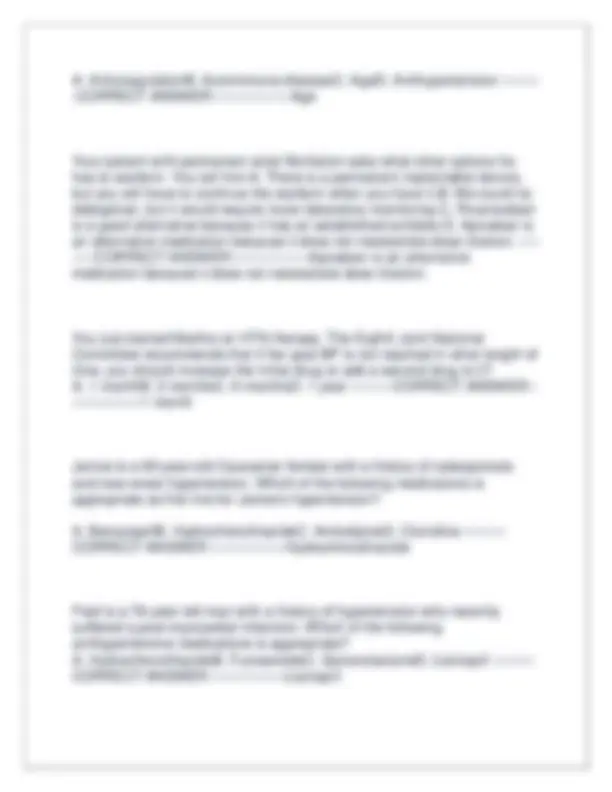
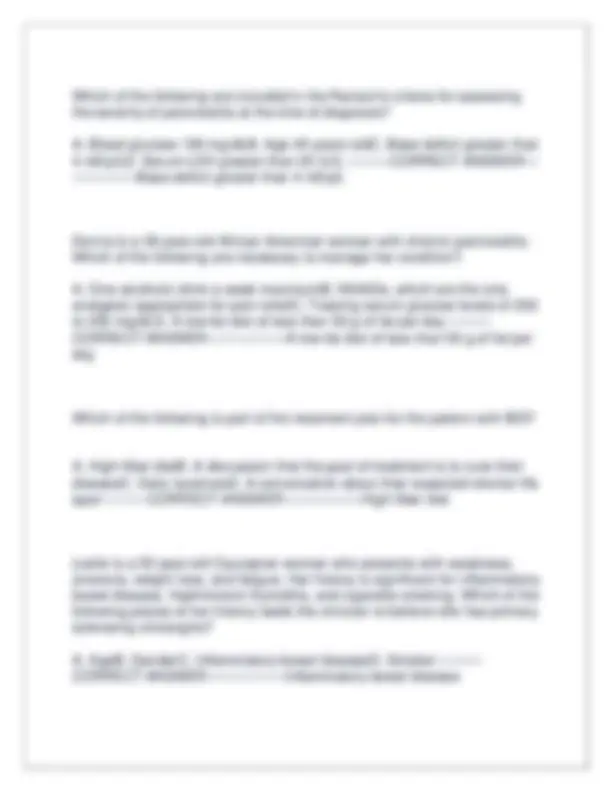
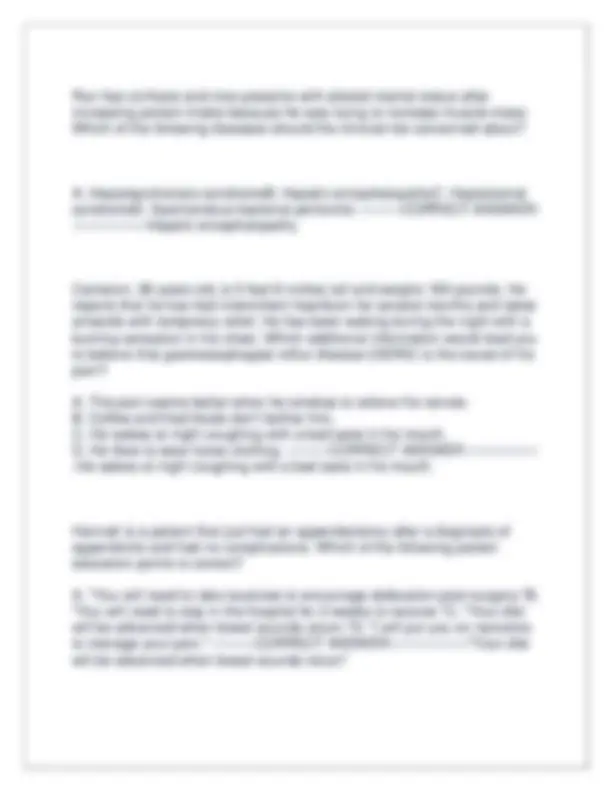

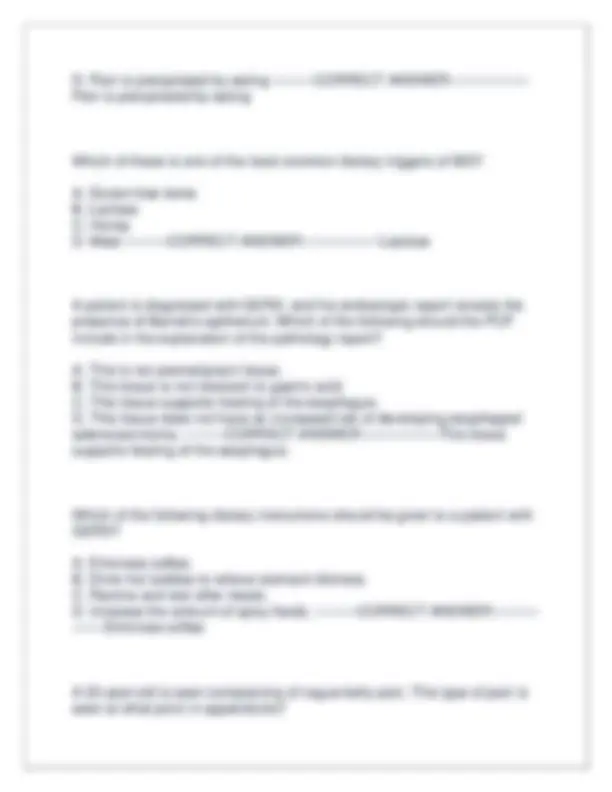
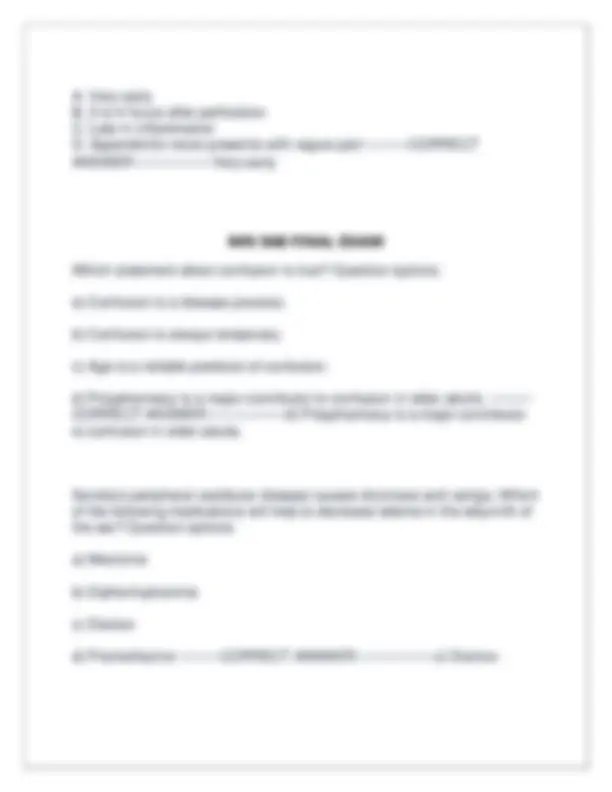
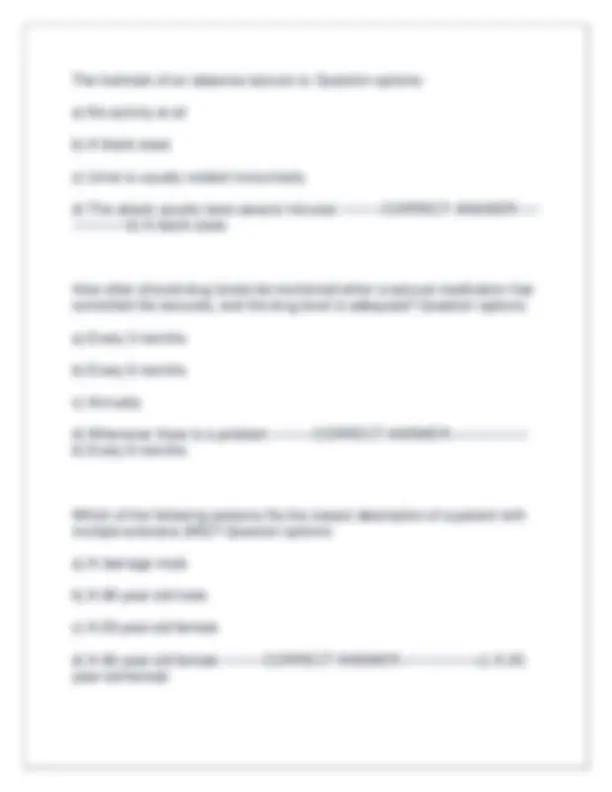
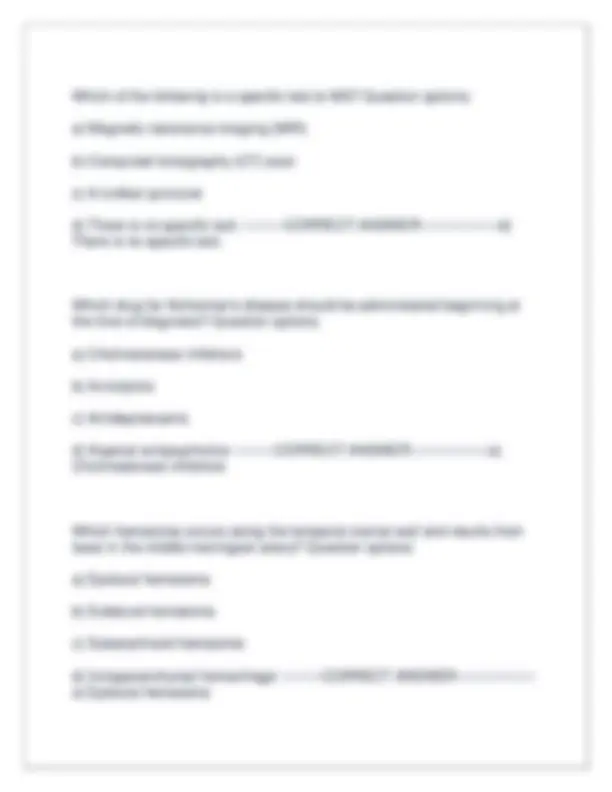
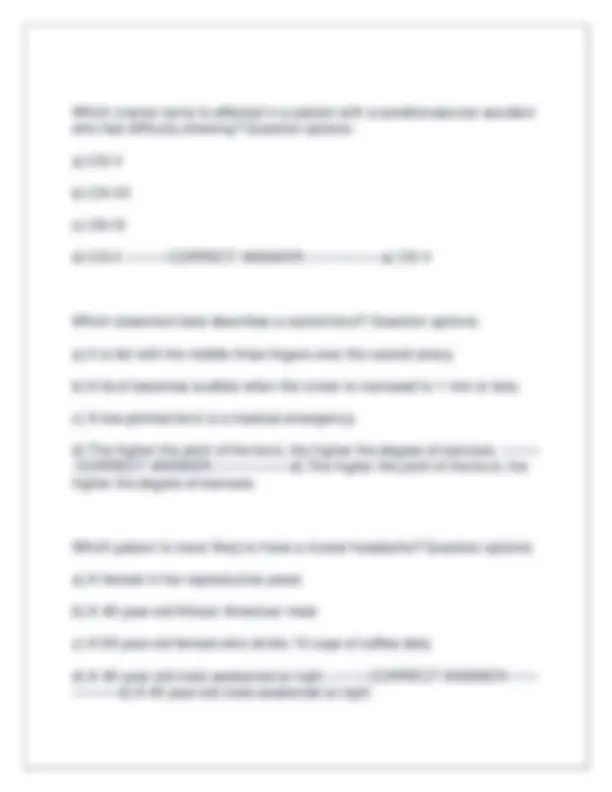
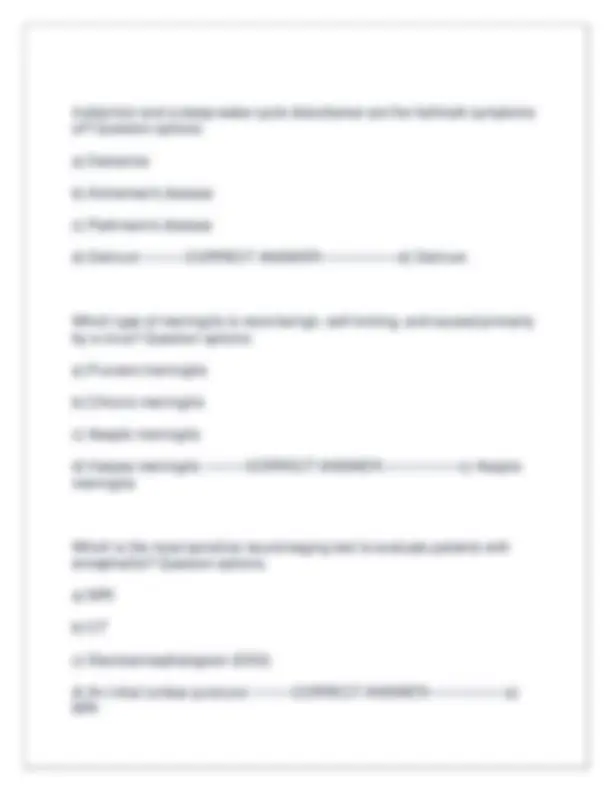
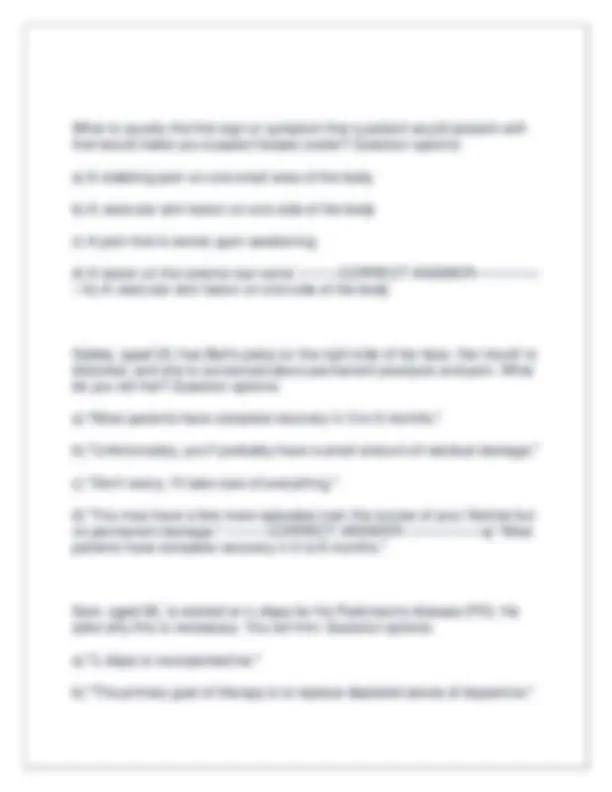
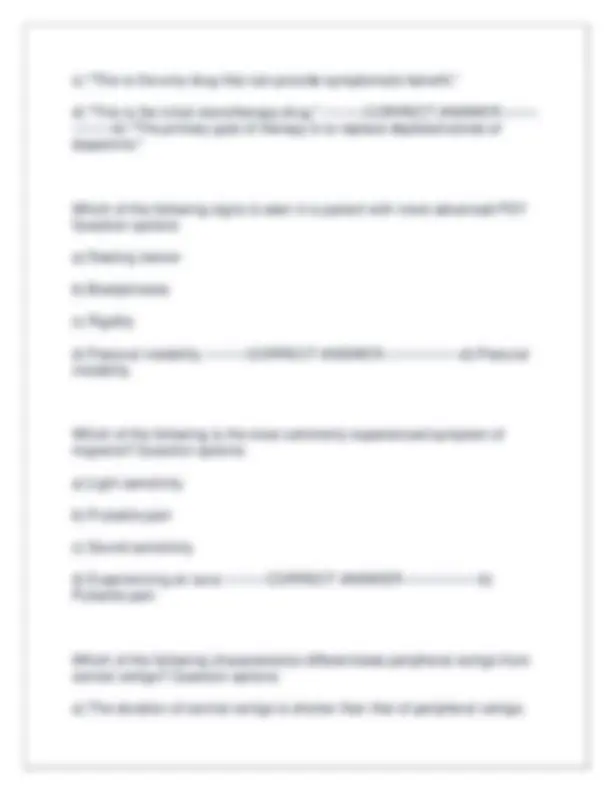
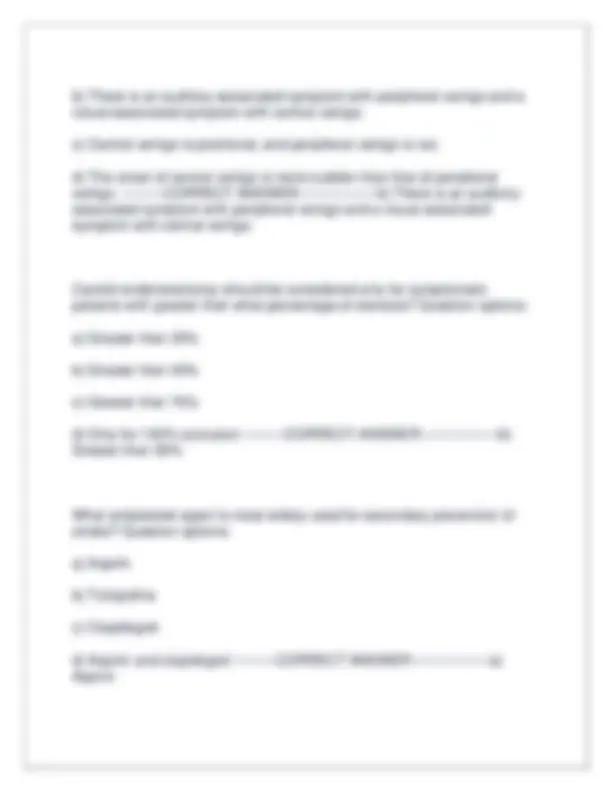
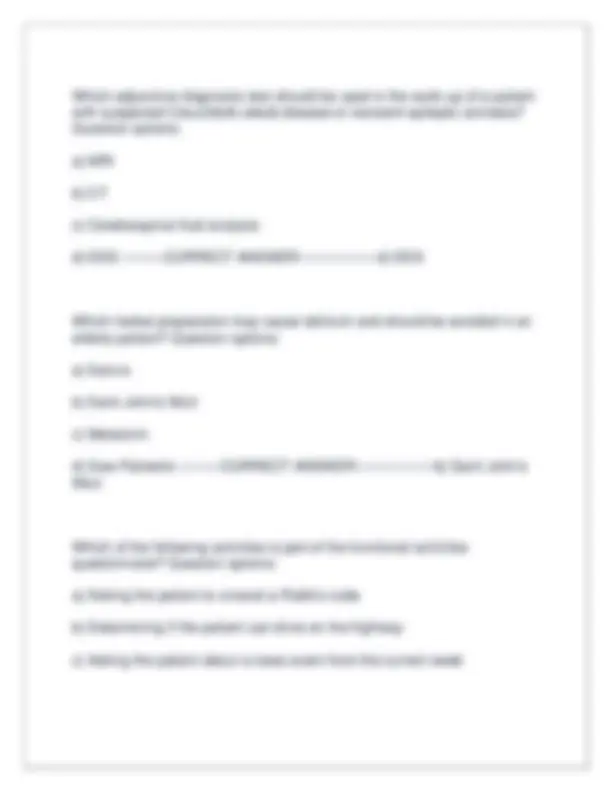
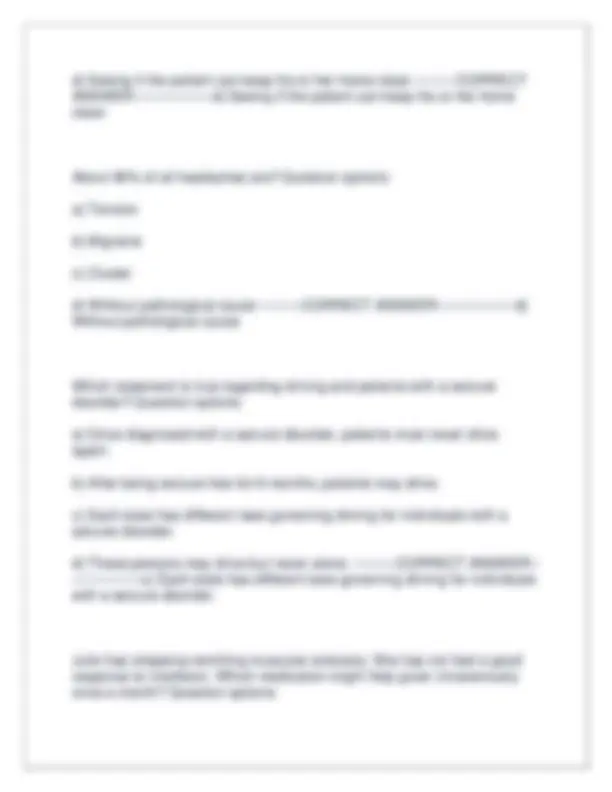
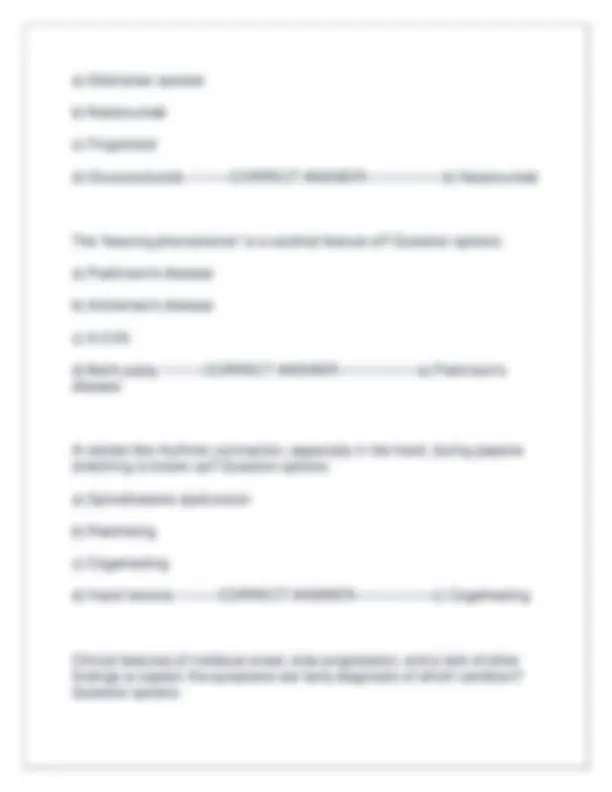
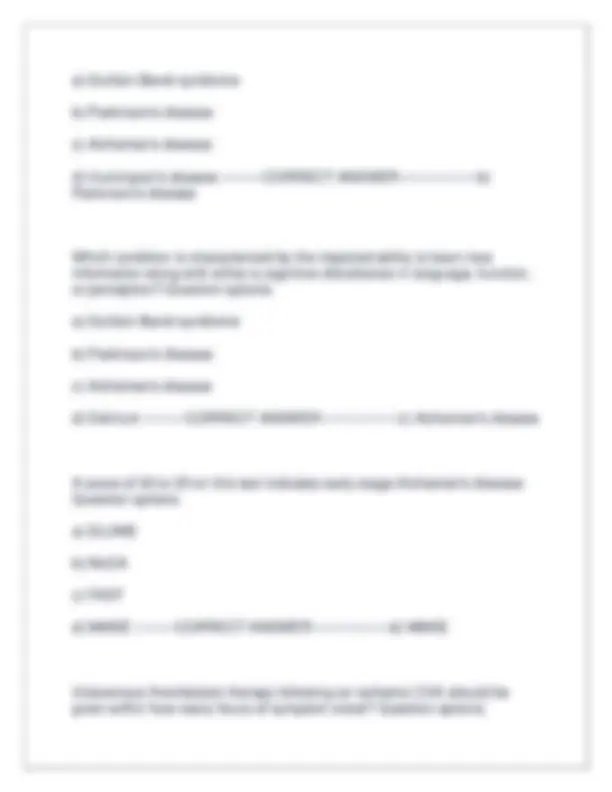
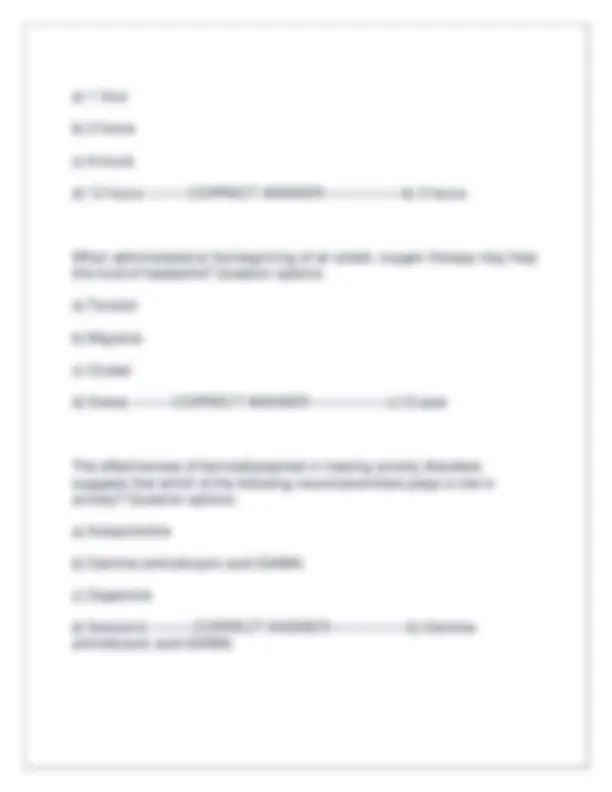
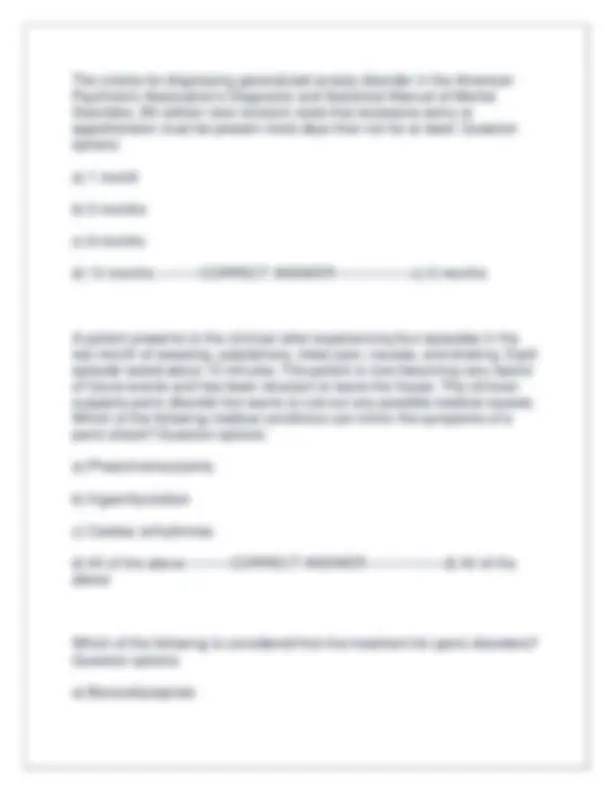
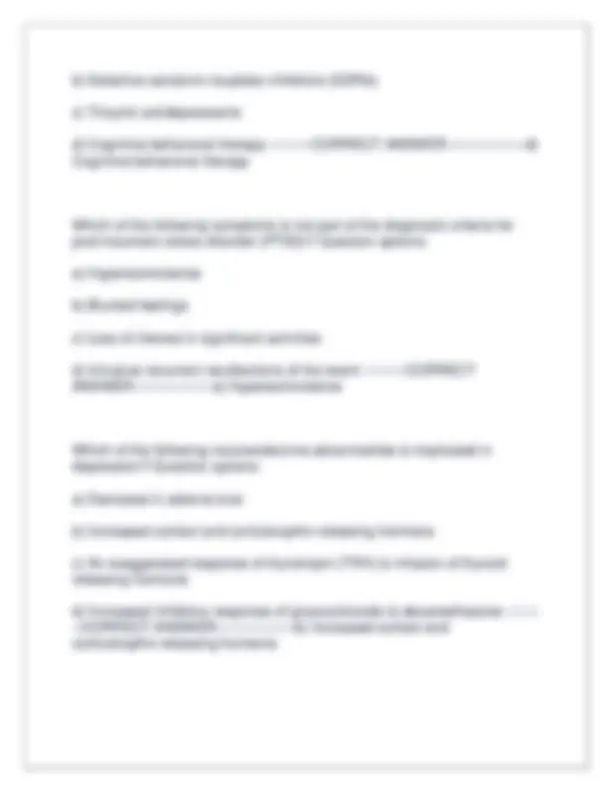
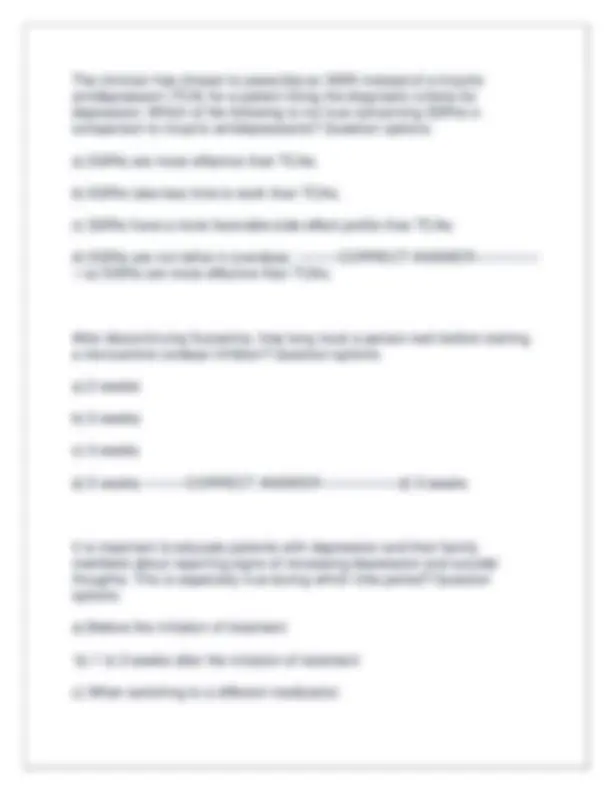
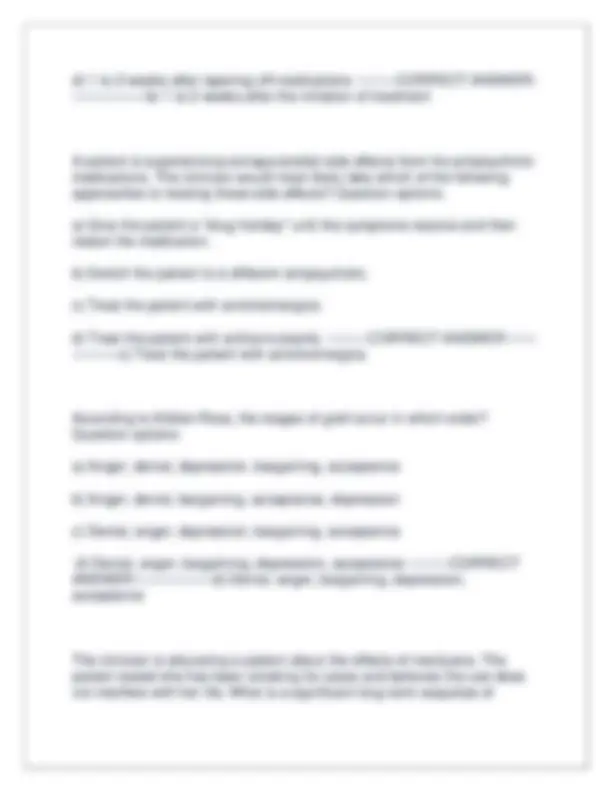
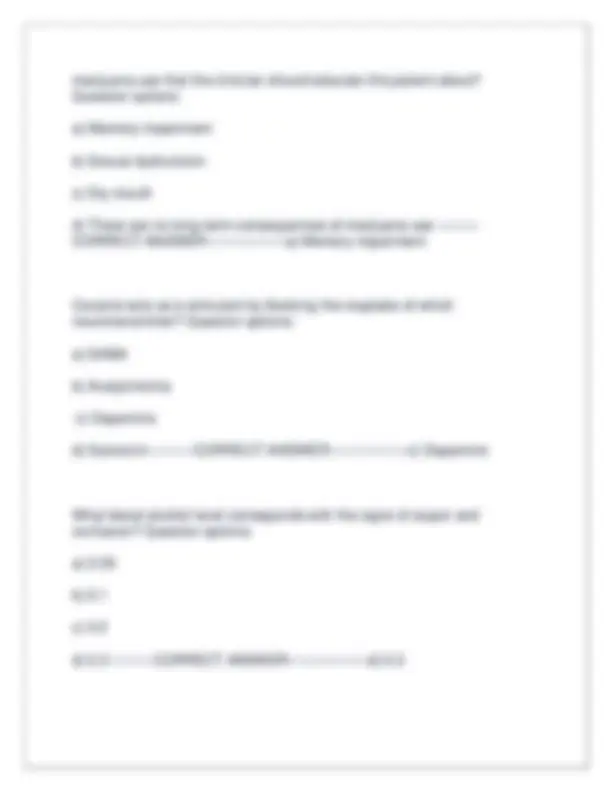
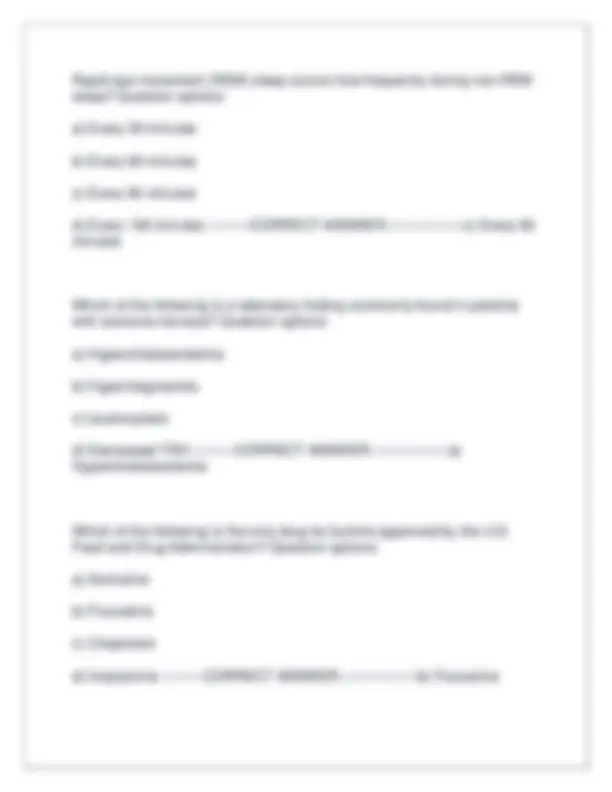
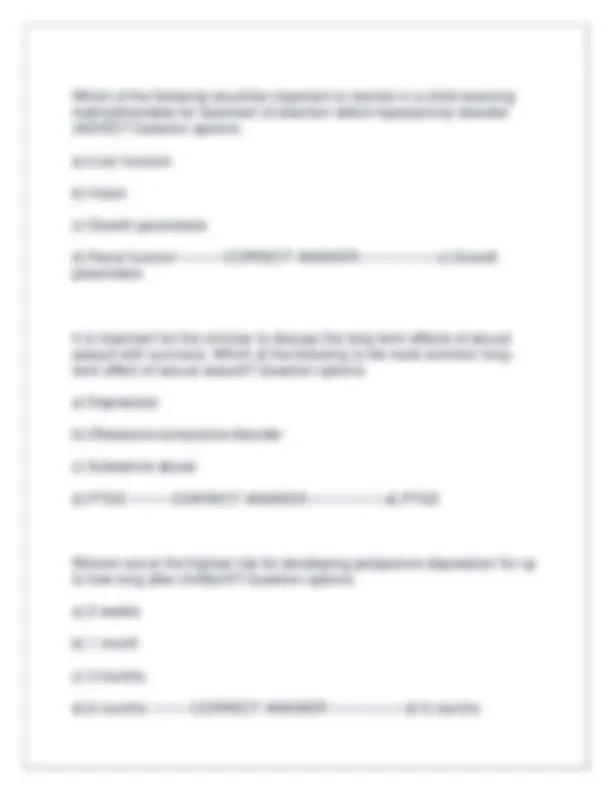
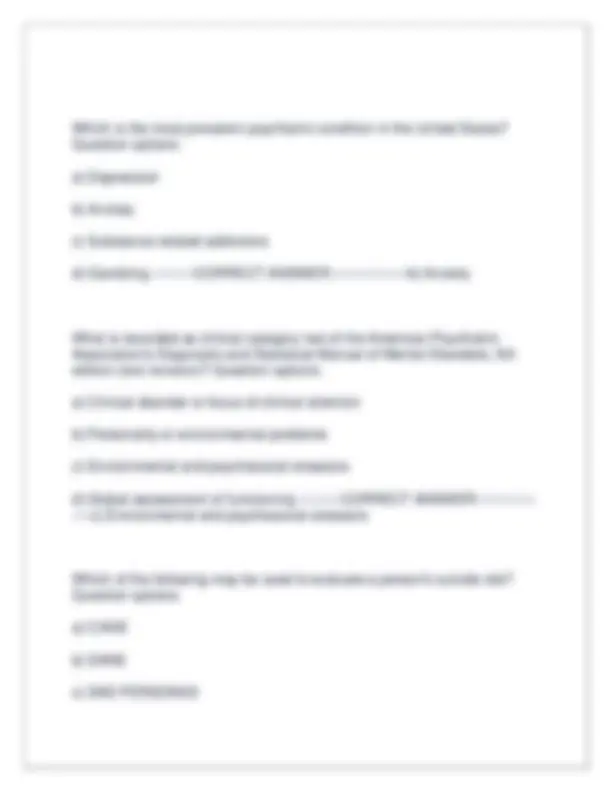
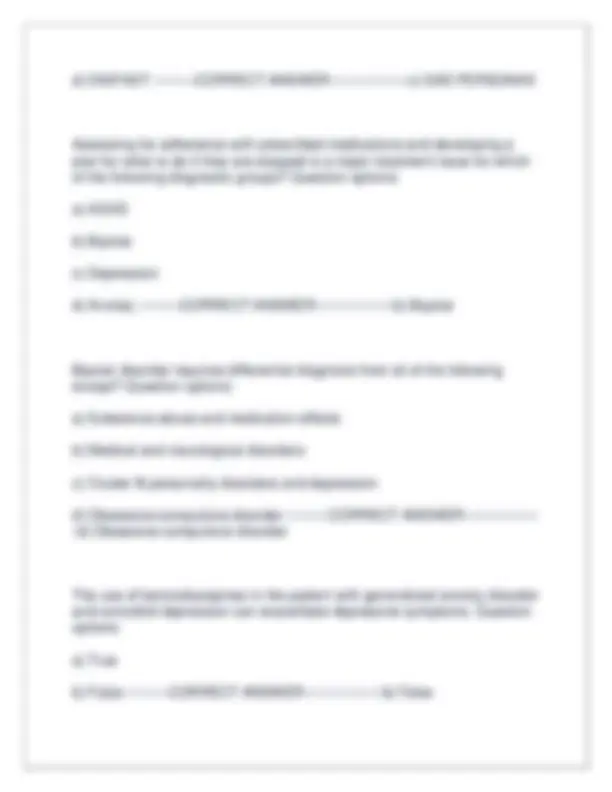
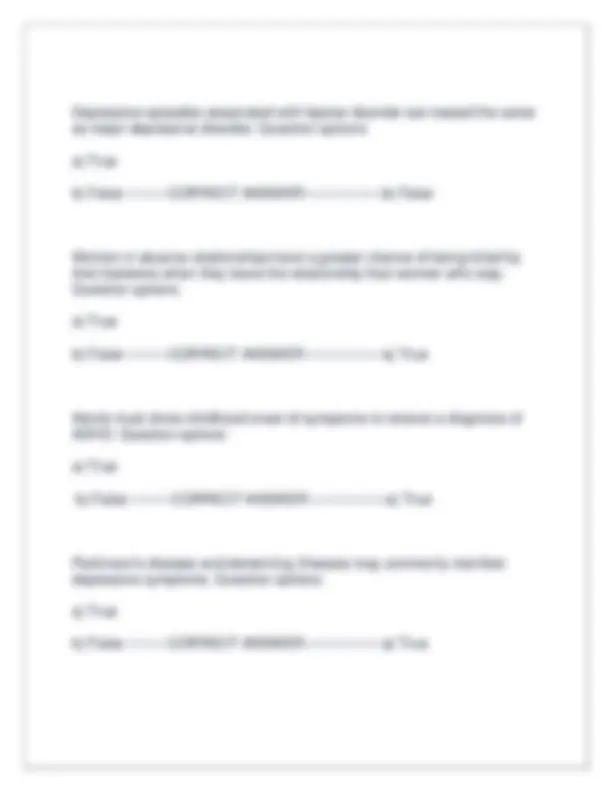
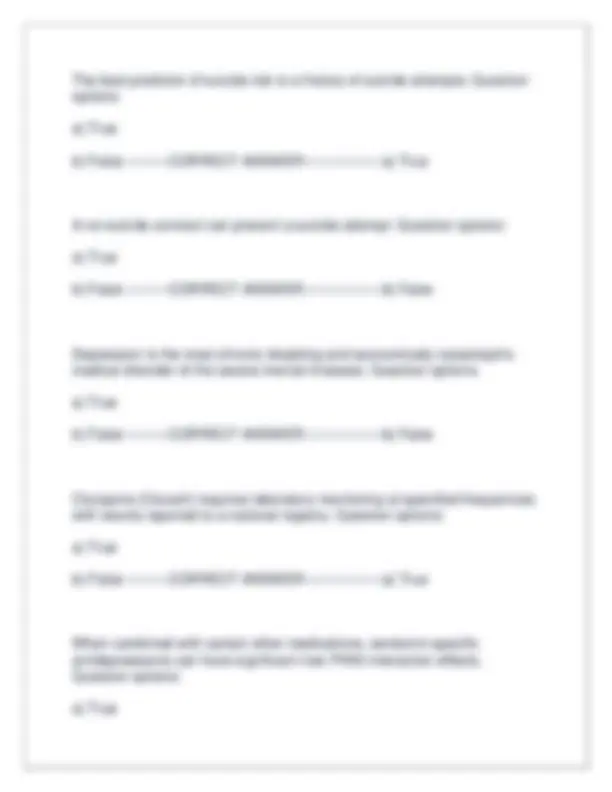
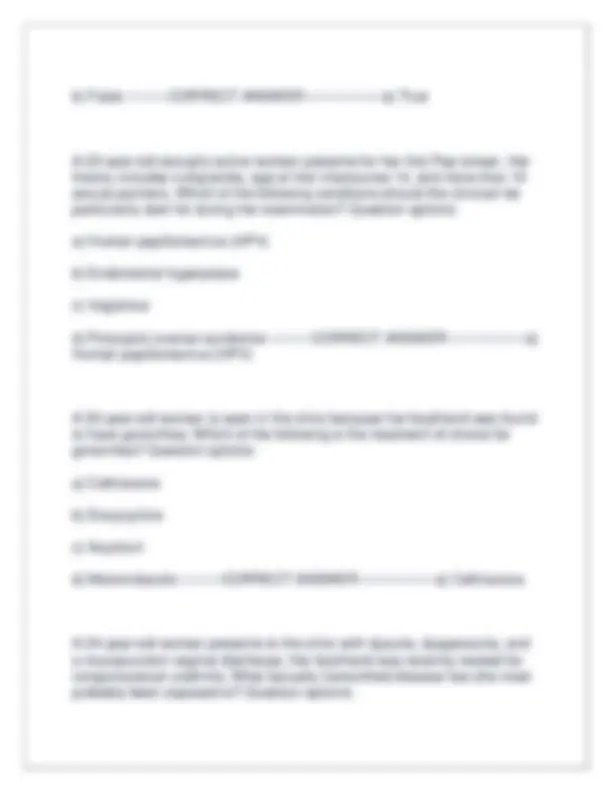
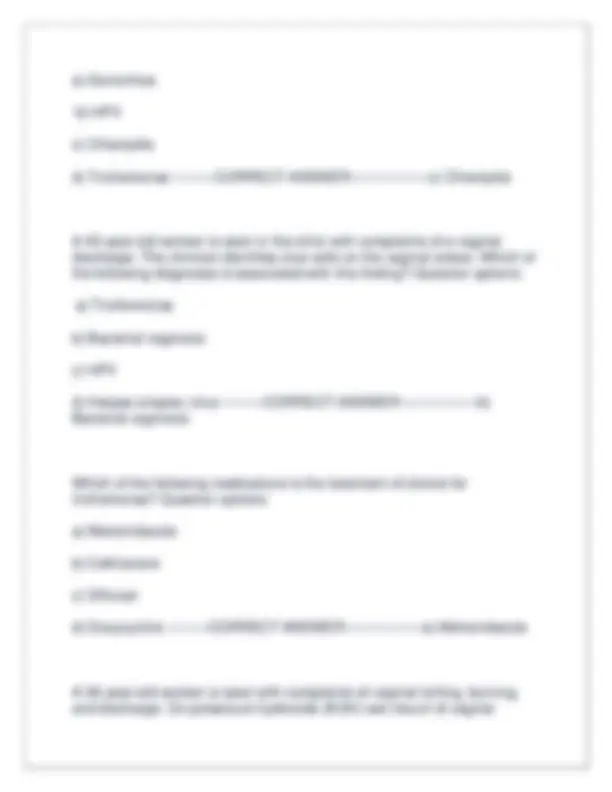
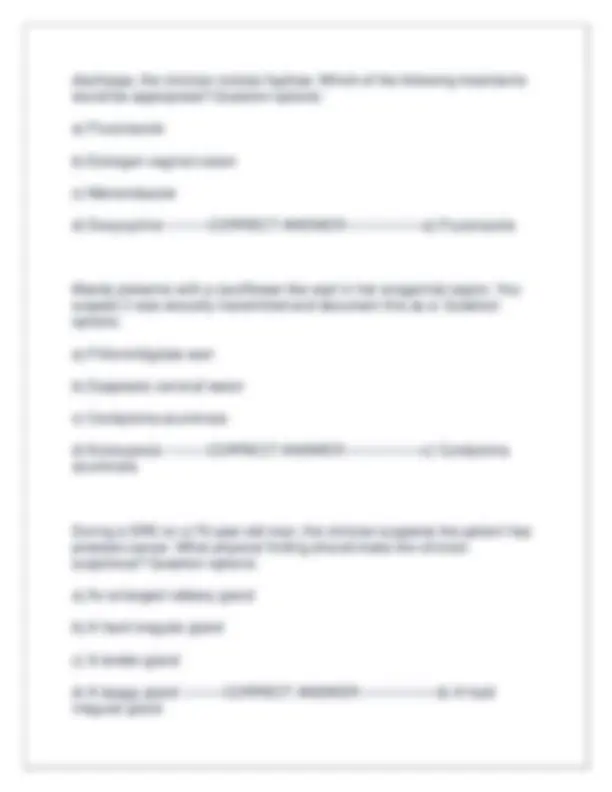
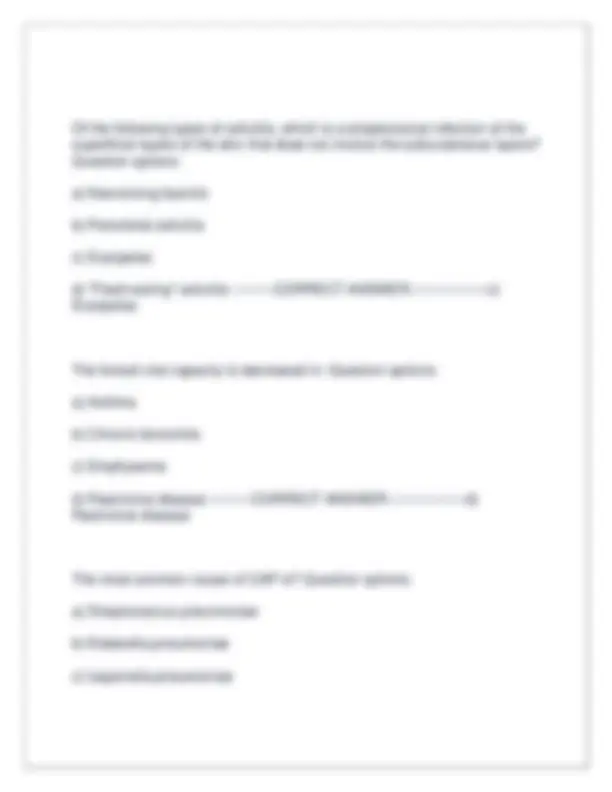
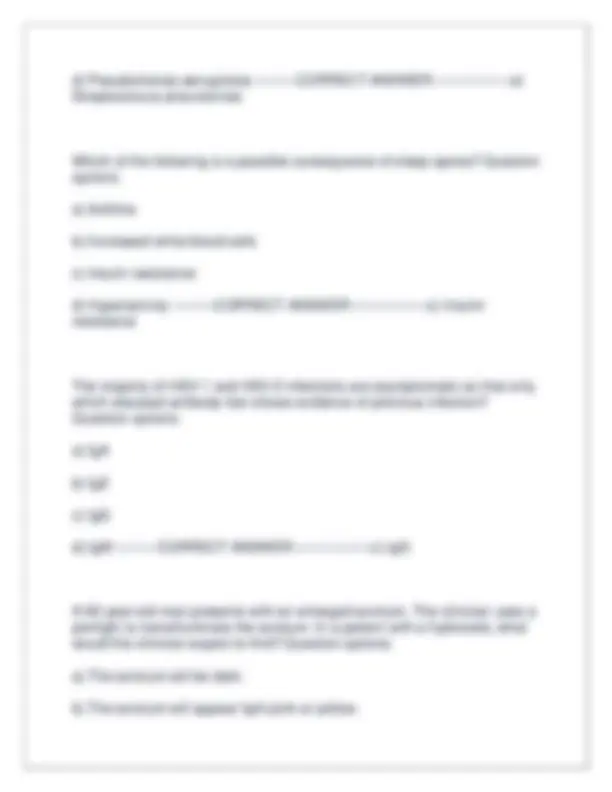
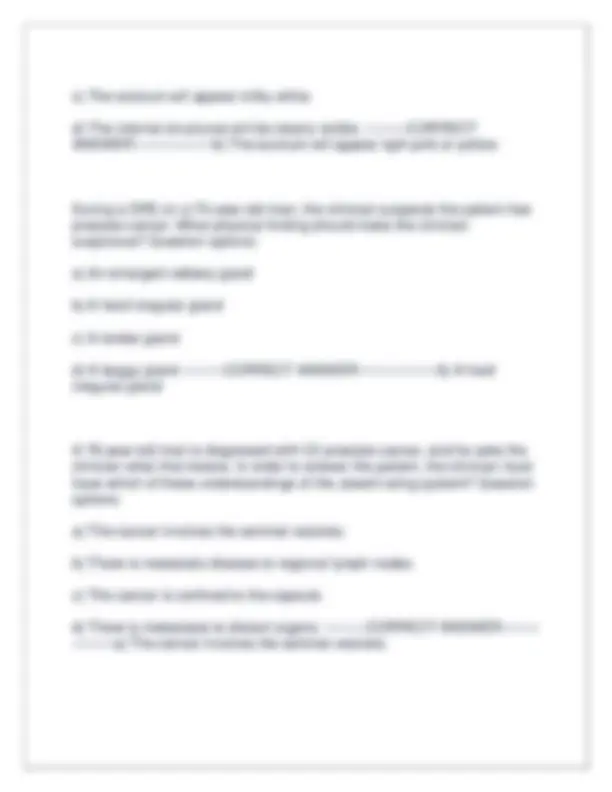
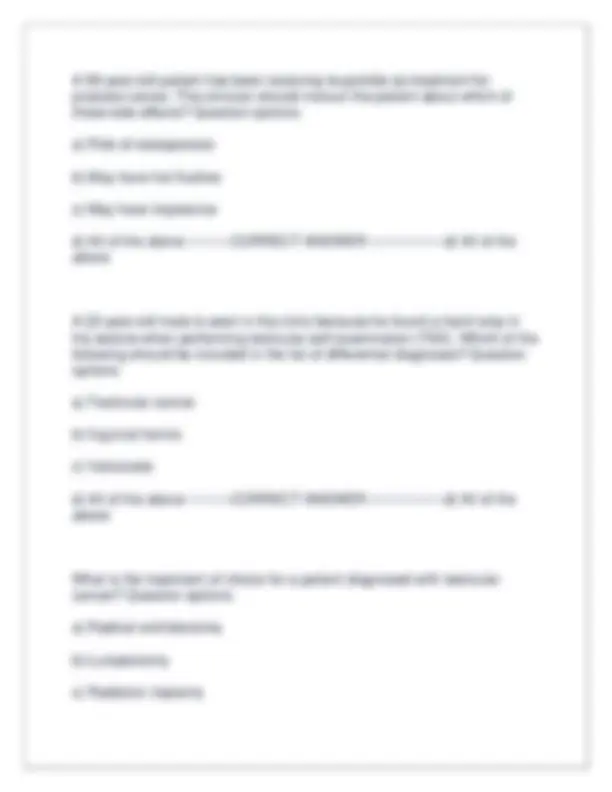
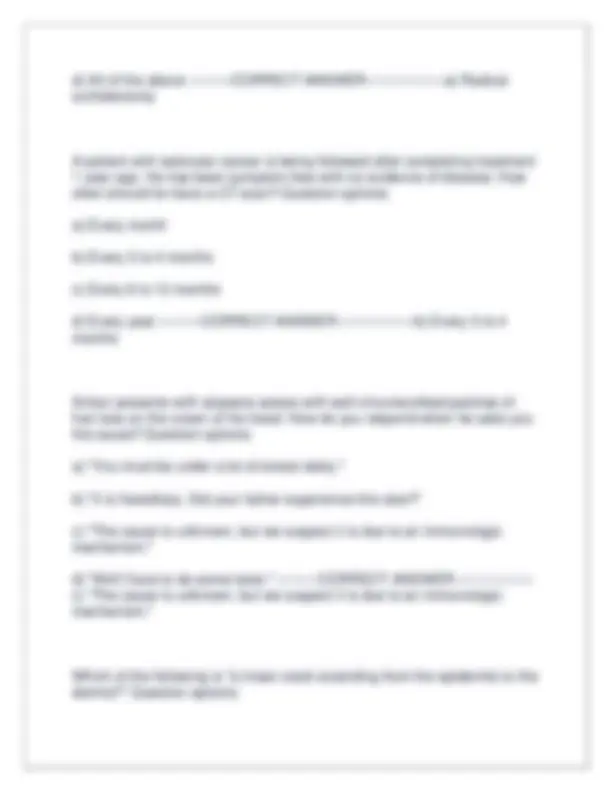
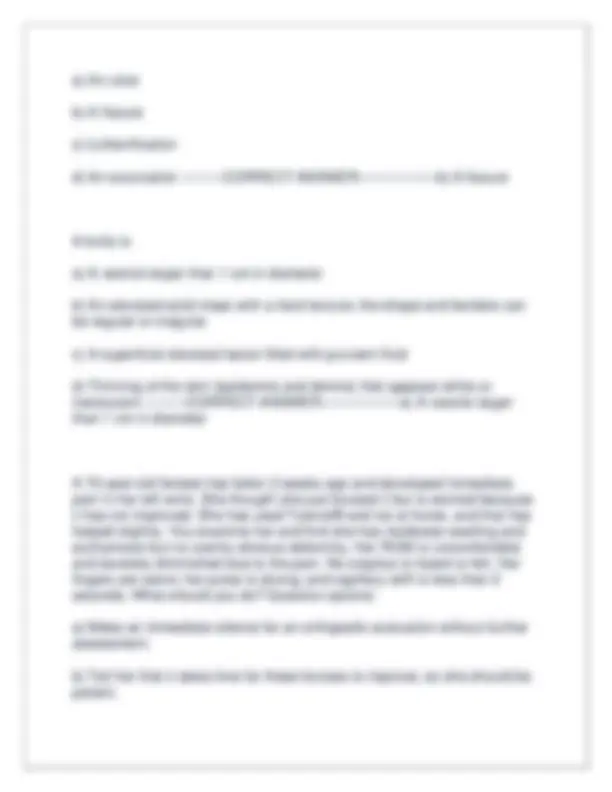
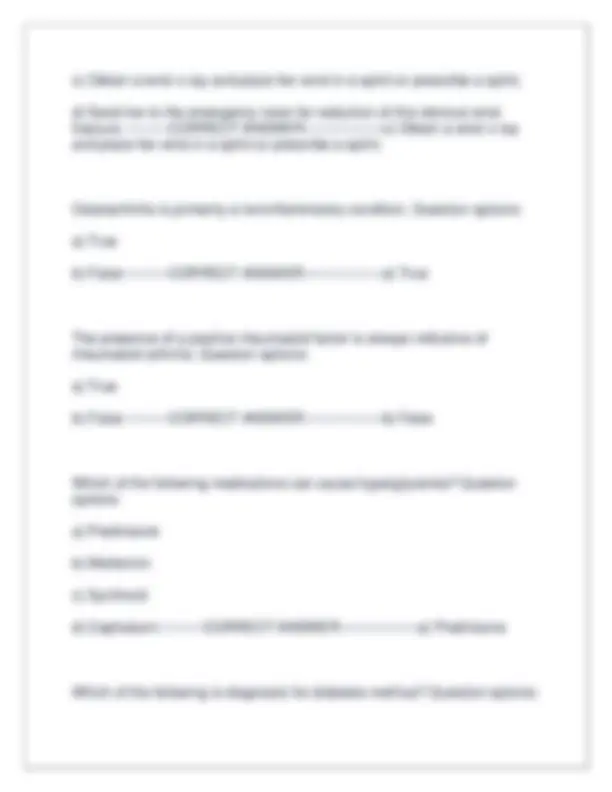
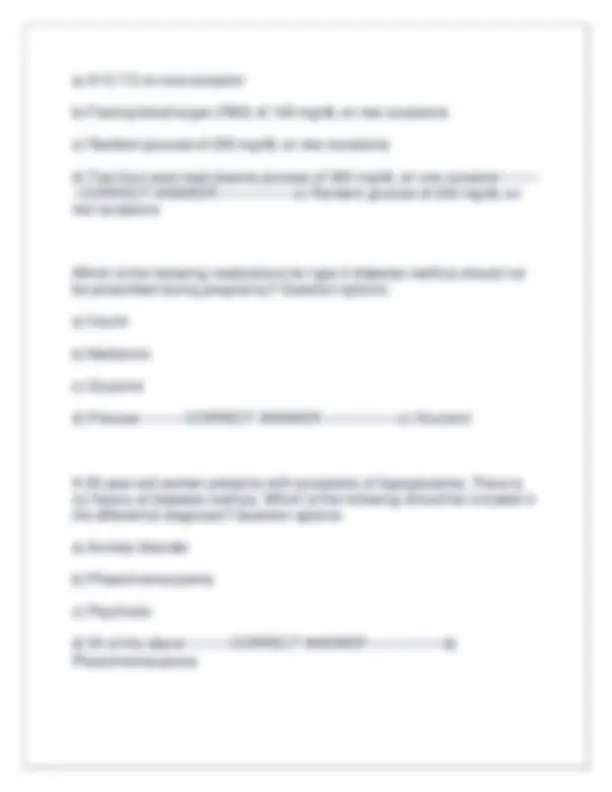


Study with the several resources on Docsity

Earn points by helping other students or get them with a premium plan


Prepare for your exams
Study with the several resources on Docsity

Earn points to download
Earn points by helping other students or get them with a premium plan
Community
Ask the community for help and clear up your study doubts
Discover the best universities in your country according to Docsity users
Free resources
Download our free guides on studying techniques, anxiety management strategies, and thesis advice from Docsity tutors
MN 568 MIDTERM AND FINAL EXAM (ACTUAL EXAMS) | ALL QUESTIONS AND CORRECT ANSWERS | GRADED A+ | VERIFIED ANSWERS | LATEST VERSIONS 2025 (JUST RELEASED)
Typology: Exams
1 / 80

This page cannot be seen from the preview
Don't miss anything!









































































The patient has hyperosmolar hyperglycemic syndrome. Which laboratory findings would the clinician observe? A. Plasma bicarbonate 8 mEq/L B. Blood glucose level 40 mg/dL C. Serum osmolality 420 mOsm/kg D. Blood pH 7.20 ---------CORRECT ANSWER-----------------Serum osmolality 420 mOsm/kg Which question should the clinician ask to determine the most frequent cause of diabetic ketoacidosis? A. "How often are you taking the insulin?" B. "Which type of infection have you experienced recently?" C. "What type of diet have you been following?" D. "Is there any reason you don't like taking your medications?" --------- CORRECT ANSWER-----------------"Which type of infection have you experienced recently?" A patient with type 1 diabetes has diabetic ketoacidosis. Which first-line treatment should the clinician prescribe? A. NPH insulin B. Regular insulin C. IV normal saline
D. Thiazolidinedione ---------CORRECT ANSWER-----------------Regular insulin A nondiabetic patient has idiopathic hypoglycemia. Which dietary instruction should the clinician share with the patient? A. Follow a low-protein, high-carbohydrate diet B. Allow caffeine at each meal C. Avoid nuts and seeds D. Eat six small meals a day ---------CORRECT ANSWER-----------------Eat six small meals a day The clinician is using the HALT acronym to help a patient identify overeating triggers. What does the "T" represent? A. Tired B. Tense C. Temper D. Threats ---------CORRECT ANSWER-----------------Tired The patient weighs 350 lbs and is on a weight loss program. After 6 months, which ideal weight in pounds should the clinician observe? A. 335 B. 325 C. 315 D. 305 ---------CORRECT ANSWER----------------- 315 Which instruction should the clinician include in patient teaching regarding management of obesity? A. Occasionally skipping meals is acceptable. B. Try to use nonstick cookware when baking or frying.
A patient with hypertension comes in and insists that one of his new medications is causing him to cough. When looking at his list of medications, you think the cough must be from: A. Metoprolol B. Clopidogrel C. Tadalafil D. Captopril ---------CORRECT ANSWER-----------------Captopril Which of the following scales is useful to assess the degree of dyspnea with a score of 6 to 20? A. Borg scale B. Patient Health Questionnaire-9 scale C. Visual analog scale D. Global assessment of functioning scale ---------CORRECT ANSWER----- ------------Borg scale Lisa is a 25-year-old Hispanic female experiencing chest tightness, a feeling of suffocation, and feels like she "can't get air in." She has no current history of heart or lung disease and did not exercise leading up to this attack. Which of the following is the most likely cause for this dyspnea? A. Severe chronic anemia B. Congestive heart failure C. Anxiety-related dyspnea D. Chronic obstructive pulmonary disease (COPD) ---------CORRECT ANSWER-----------------Anxiety-related dyspnea Which of the following statements regarding pulmonary function is true? a. Cigarette smoking accelerates the decline in pulmonary function tenfold b. Smoking cessation can reverse most pathological changes c. Cigarette smoking decreases mucus production
d. There is a normal age-related decline in pulmonary function --------- CORRECT ANSWER-----------------There is a normal age-related decline in pulmonary function Supplemental oxygen for how many hours per day has been shown to improve the mortality associated with COPD? ---------CORRECT ANSWER- ---------------- 15 - 18 hours The barrel chest characteristic of emphysema is a result of: --------- CORRECT ANSWER-----------------hyperinflation Which ethnic group has the highest lung cancer incidence and mortality rates? ---------CORRECT ANSWER-----------------African American men A pt is 66in in height, weighing 200lbs, and newly diagnosed with T2DM. Her fasting plasma glucose level is 215mg/dL. What is the best initial treatment? ---------CORRECT ANSWER-----------------Diet and exercise for 6 week trial The clinician suspects that a client seen in the office has hyperthyroidism. Which of the following tests should the clinician order on the initial visit?
Nathan, a 32yo policeman, has a 15-pack-year history of smoking and continues to smoke heavily. During every visit, he gets irate when you try to talk to him about quitting. What should you do? ---------CORRECT ANSWER-----------------Continue to ask him at every visit if he is ready to quit Your pt has decided to try to quit smoking with Chantix. You are discussing his quit date and he will begin taking the med tomorrow. When should he plan to quit smoking? ---------CORRECT ANSWER-----------------His quit date should be in 1 week Which info should be included when you are teaching your pt about the use of nicotine gum? ---------CORRECT ANSWER-----------------The gum must be correctly chewed to a softened state and then placed in the buccal mucosa Cydney presents with a h/o asthma. She has not been treated for a while. She c/o daily but not continual symptoms, greater than 1 week and at nighttime. She has been using her rescue inhaler. Her FEV1 is 60-80% predicted. How would you classify her asthma severity? ---------CORRECT ANSWER-----------------Moderate persistent Joyce is taking a long-acting beta agonist for her asthma. What additional med should she be taking? ---------CORRECT ANSWER----------------- Inhaled corticosteroid
Your pt is on theophylline (Therabid) for his asthma. You want to maintain his serum levels between: ---------CORRECT ANSWER----------------- 5 - 15mcg/mL Which of the following statements regarding TST is true? ---------CORRECT ANSWER-----------------The size of the TST reaction has nothing to do with erythema but is based solely on induration Which obstructive lung disease is classified as reversible? --------- CORRECT ANSWER-----------------asthma You have taught Jennifer, age 15, about using a flow meter to assess how to manage her asthma exacerbations. She calls you today because her peak expiratory flow rate is 65%. What would you tell her? --------- CORRECT ANSWER-----------------Use your rescue inhaler, begin the Rx of PO glucocorticoids you have, and call back tomorrow." Which statement about adenocarcinoma of the lung is accurate? --------- CORRECT ANSWER-----------------It is the most prevalent carcinoma of the lungs in both sexes and in nonsmokers, representing 35-40% of all tumors Jason, age 62, has obstructive sleep apnea. What do you think is one of his contributing factors? ---------CORRECT ANSWER-----------------His collar size is 17in The forced vital capacity is decreased in: a. Asthma b. Chronic bronchitis
A pt is dx'd with hypothyroidism. Which of the following EKG changes should the clinician expect as a manifestation of the dz?
The clinician finds numerous nodules on the thyroid of a 65yo woman. The clinician suspects thyroid cancer. Which of the following data would be most significant for this pt?
Which of the following is diagnostic for DM?
C. Oral glucose tolerance test 250 mg/dL (2-hour level) D. Random plasma glucose level 175 mg/dL ---------CORRECT ANSWER-- ---------------Oral glucose tolerance test 250 mg/dL (2-hour level) Which test should the clinician order to confirm Charcot foot? A. Bone scan of lower extremities B. Computed tomography (CT) scan C. X-ray of the foot D. Culture of the foot ulcer ---------CORRECT ANSWER-----------------X-ray of the foot The clinician should question the patient with suspected gout about use of which of these medications? A. Antihypertensives B. Thiazide diuretics C. Cardiac glycosides D. Potassium supplements ---------CORRECT ANSWER----------------- Thiazide diuretics A woman presents with new-onset hoarseness with hemoptysis. For which condition should the clinician focus an examination? A. Hyperthyroidism B. Pheochromocytoma C. Cushing's syndrome D. Thyroid cancer ---------CORRECT ANSWER-----------------Thyroid cancer Which statement by the patient would indicate teaching has been successful regarding management of Cushing's syndrome at home? A. "I will take cortisone on an empty stomach." B. "I will stay away from large crowds."
C. "I will maintain a low-protein diet." D. "I will avoid foods high in potassium." ---------CORRECT ANSWER-------- ---------"I will stay away from large crowds." The patient presents to the clinic with a "buffalo hump," weight gain, easy bruising, and hyperpigmentation. Which initial diagnostic test should the clinician order? A. 1 mg overnight dexamethasone suppression test B. Abdominal computer tomography scan C. RAI uptake testing D. Early-morning salivary cortisol ---------CORRECT ANSWER----------------- 1 mg overnight dexamethasone suppression test The clinician suspects a patient has Addison's disease. Which clinical manifestation would the clinician observe upon a physical examination? A. Moon face B. Central obesity C. Hyperpigmentation D. Myxedema coma ---------CORRECT ANSWER----------------- Hyperpigmentation Which hydrocortisone dose would the clinician prescribe for a patient with Addison's disease? A. 25 to 50 mg daily B. 0.5 to 0.2 mg daily C. 20 mg in the morning and 10 mg in early evening D. 2 to 4 mg in the morning and 1 to 2 mg in the evening ---------CORRECT ANSWER-----------------20 mg in the morning and 10 mg in early evening